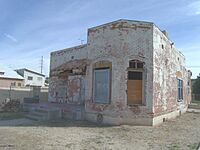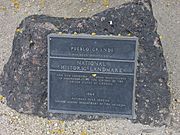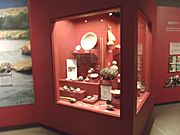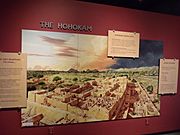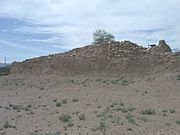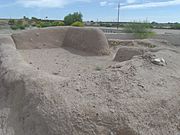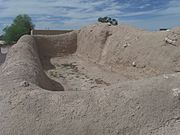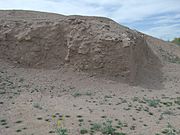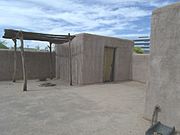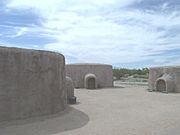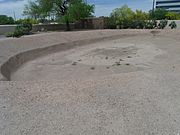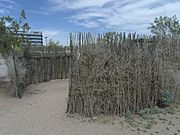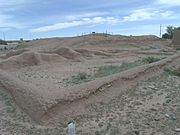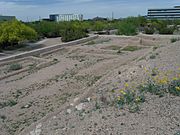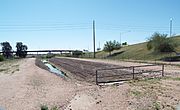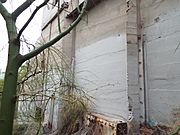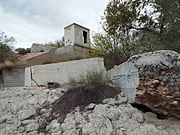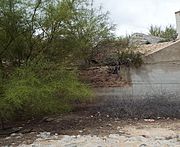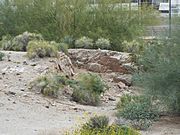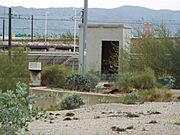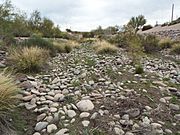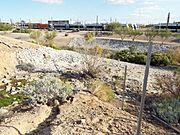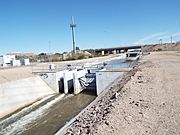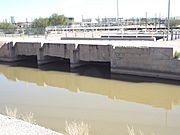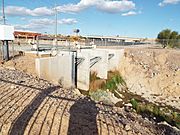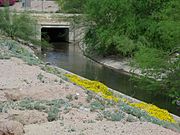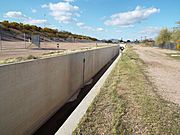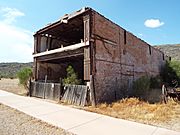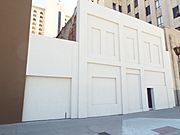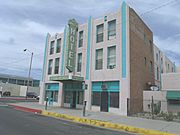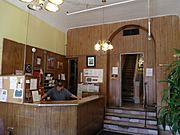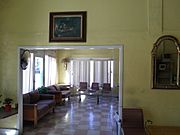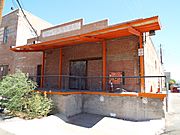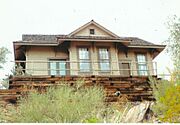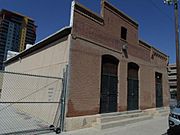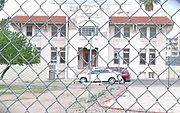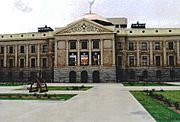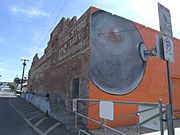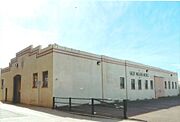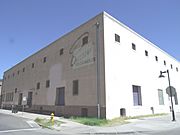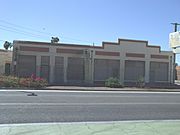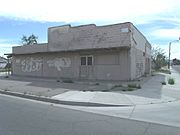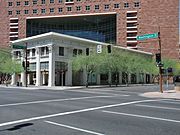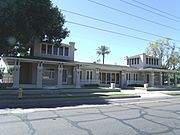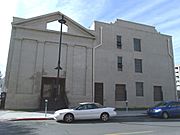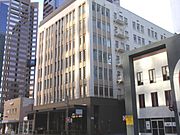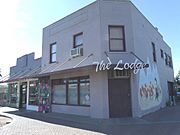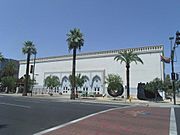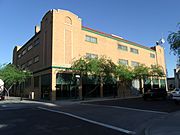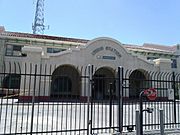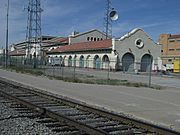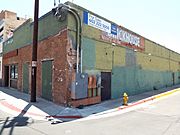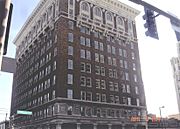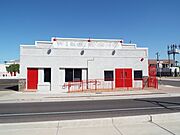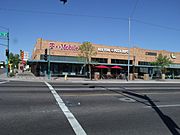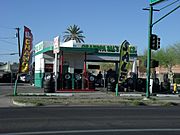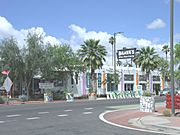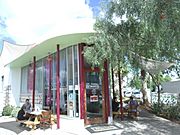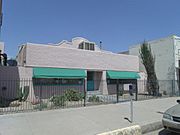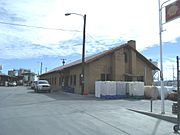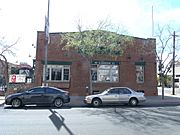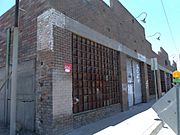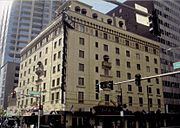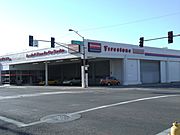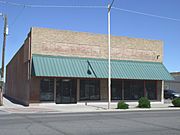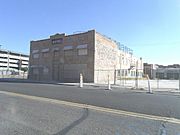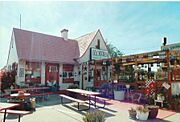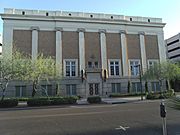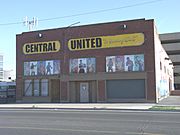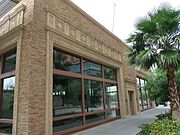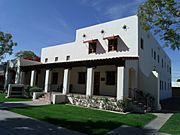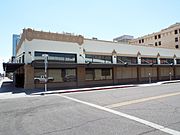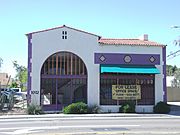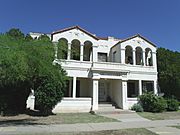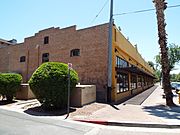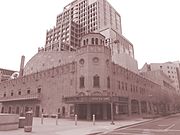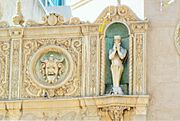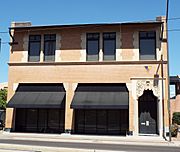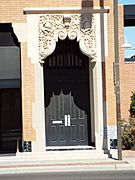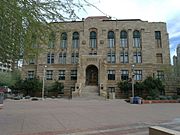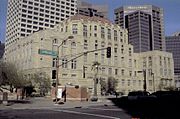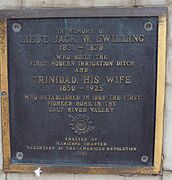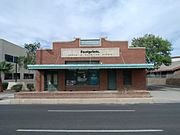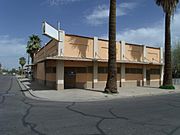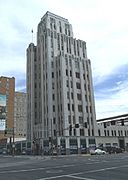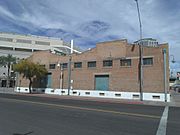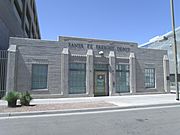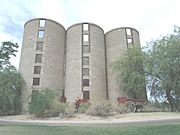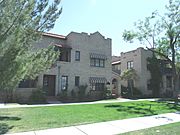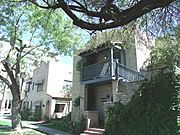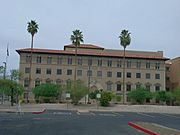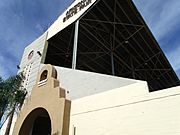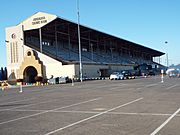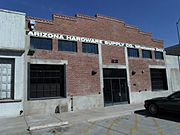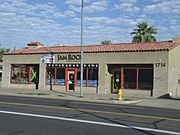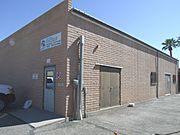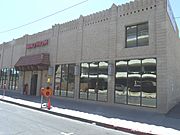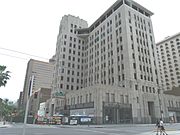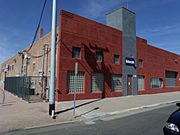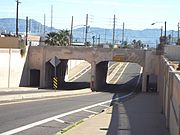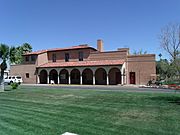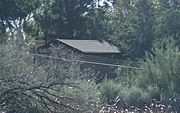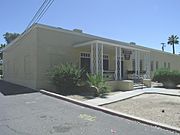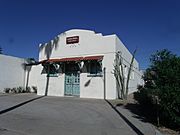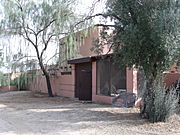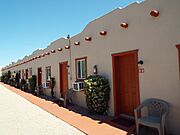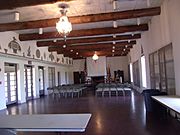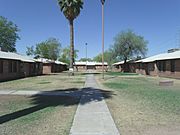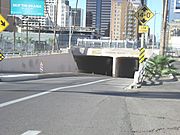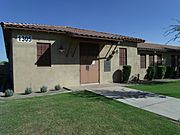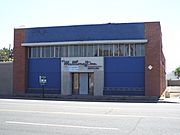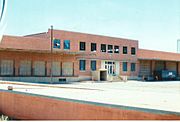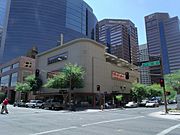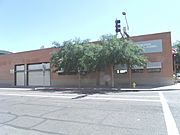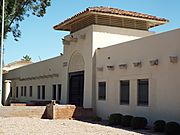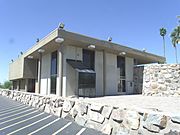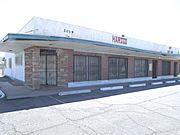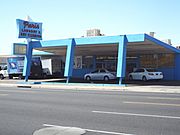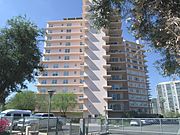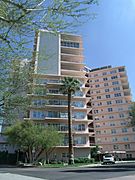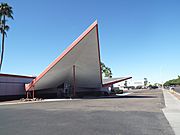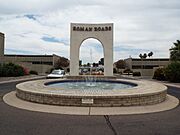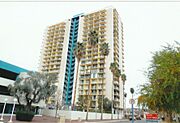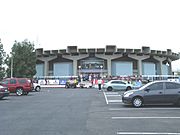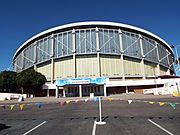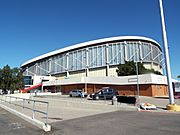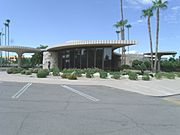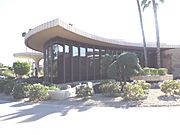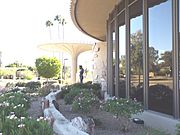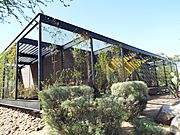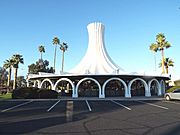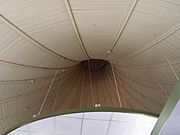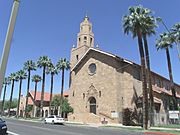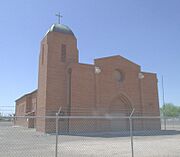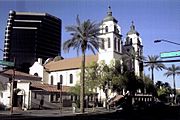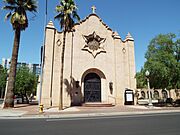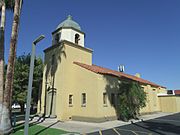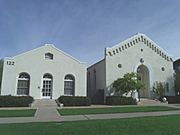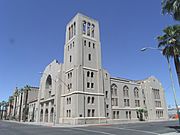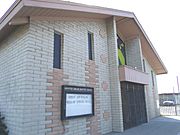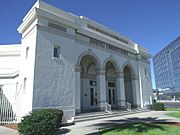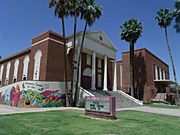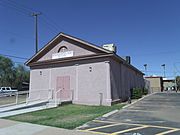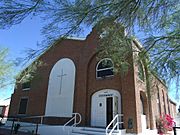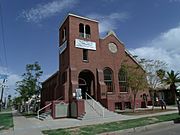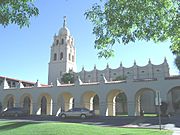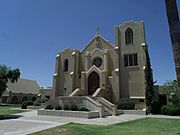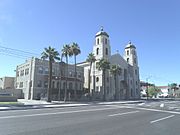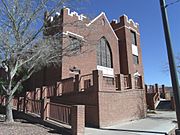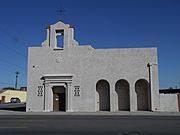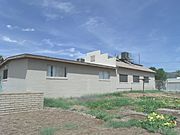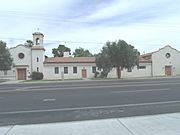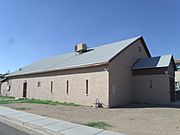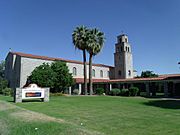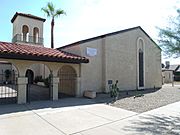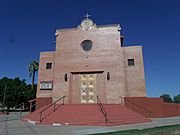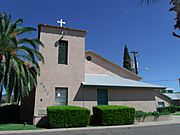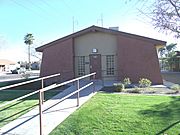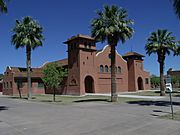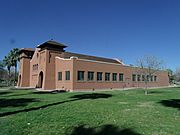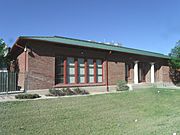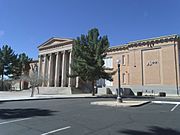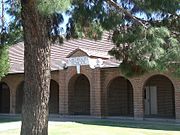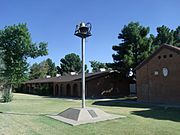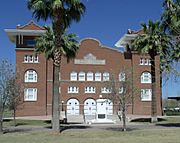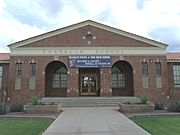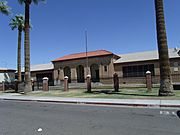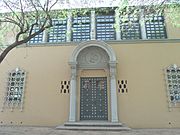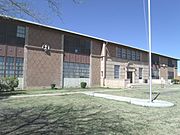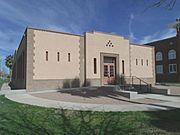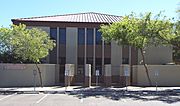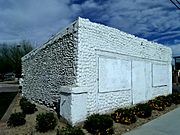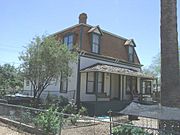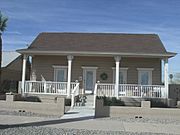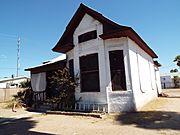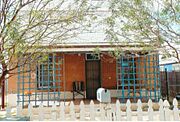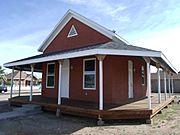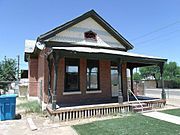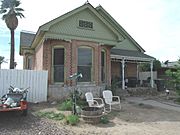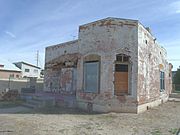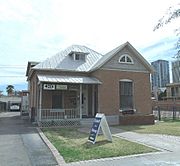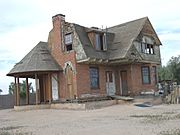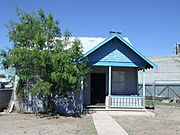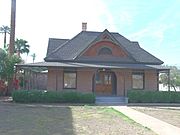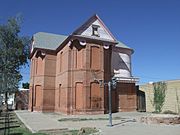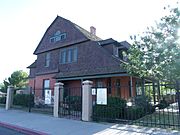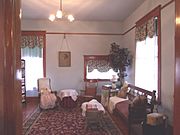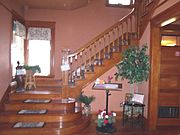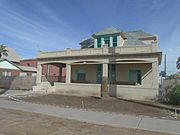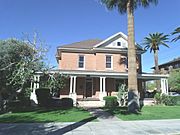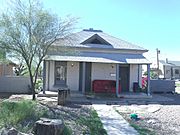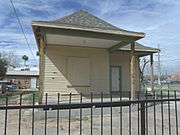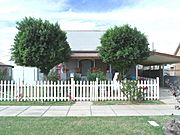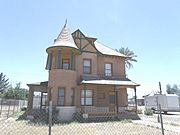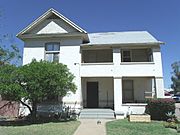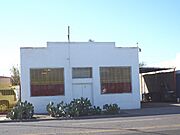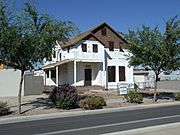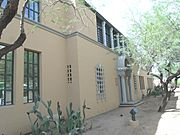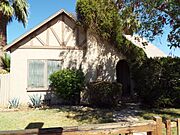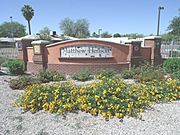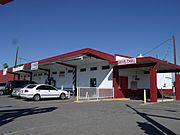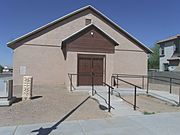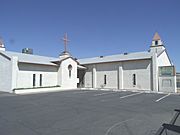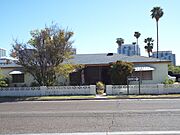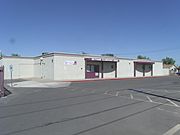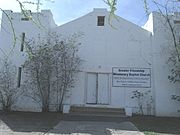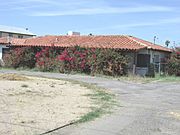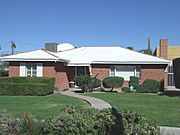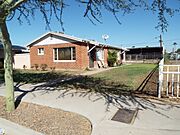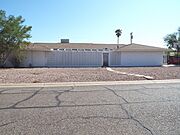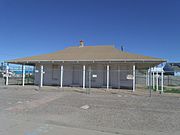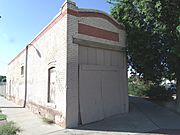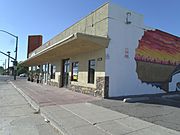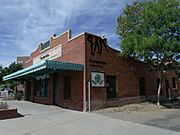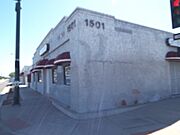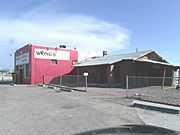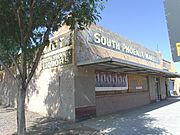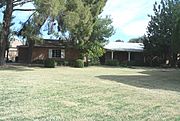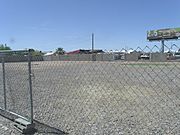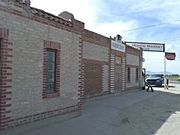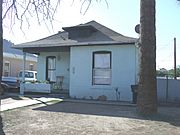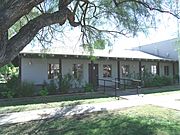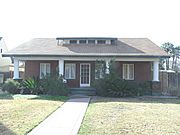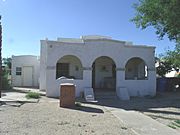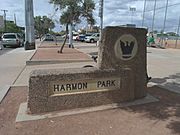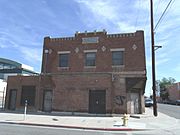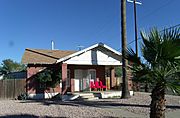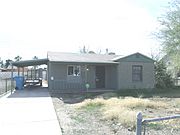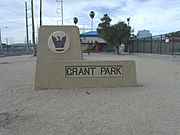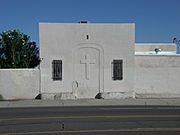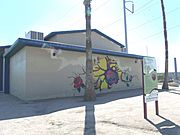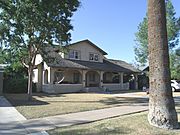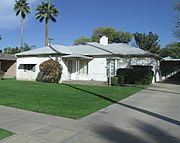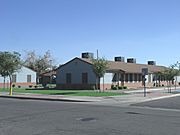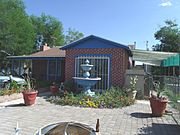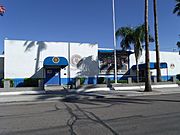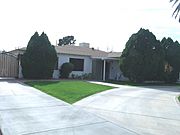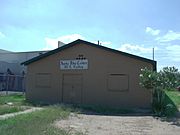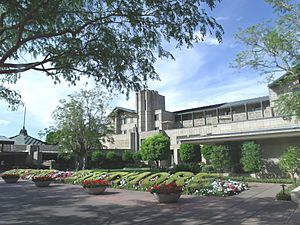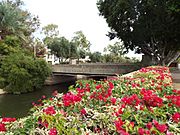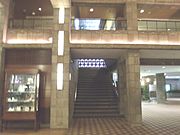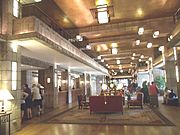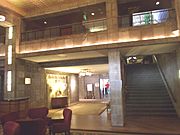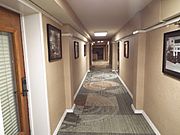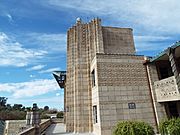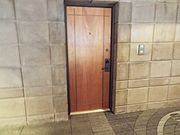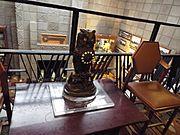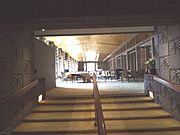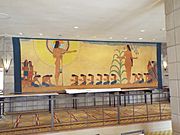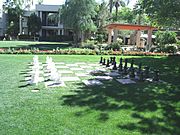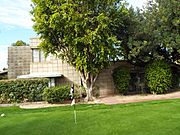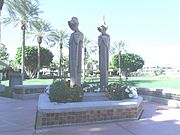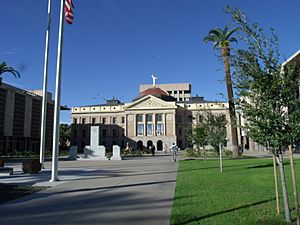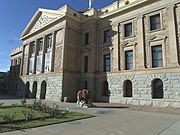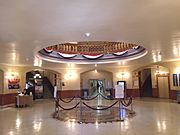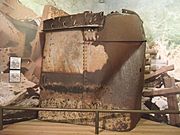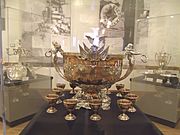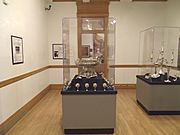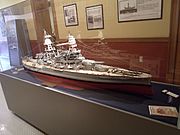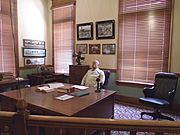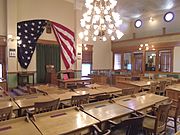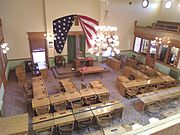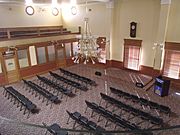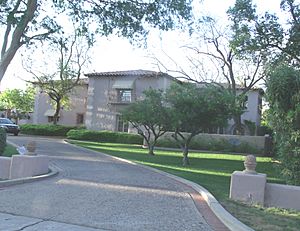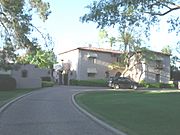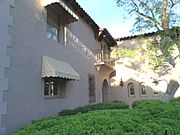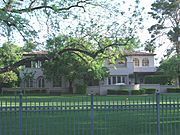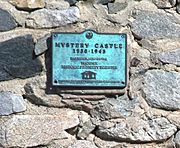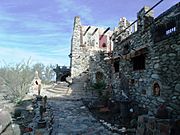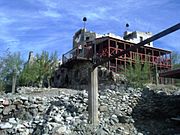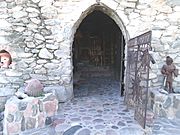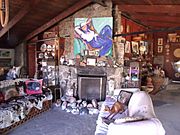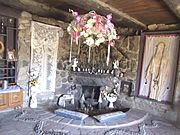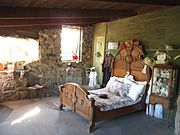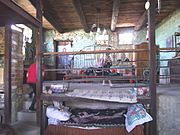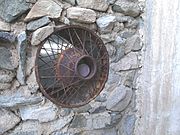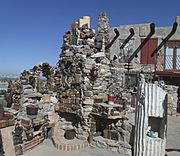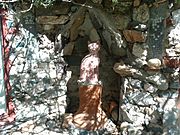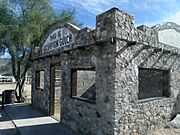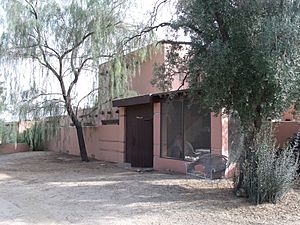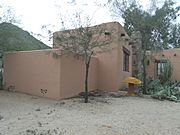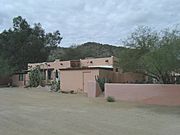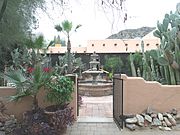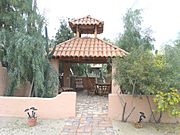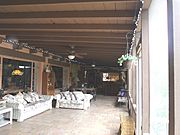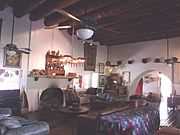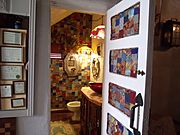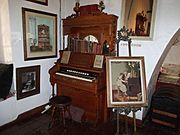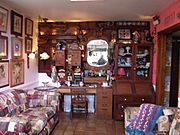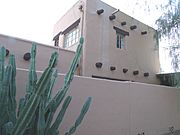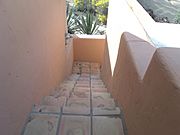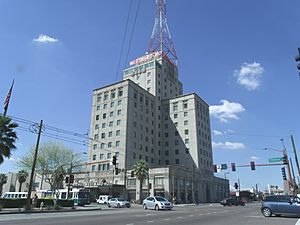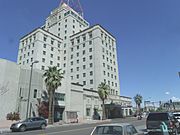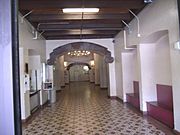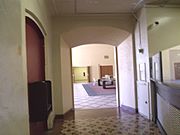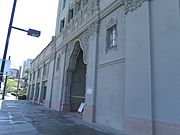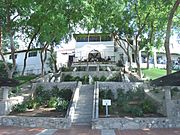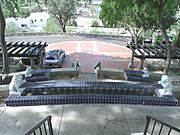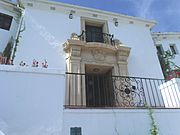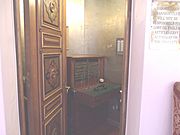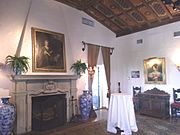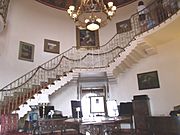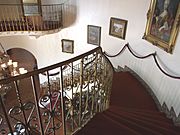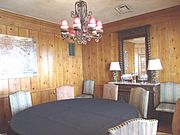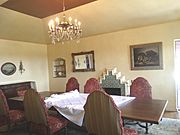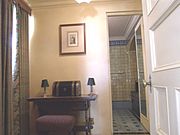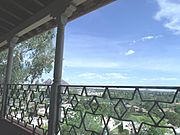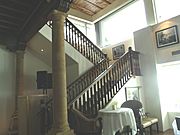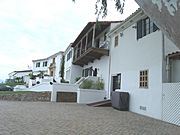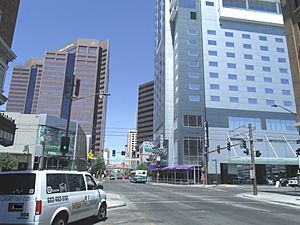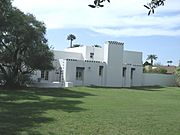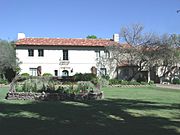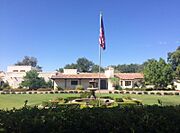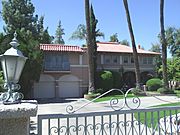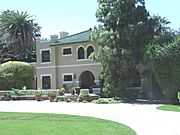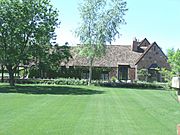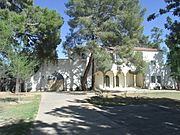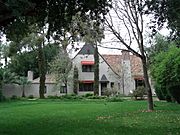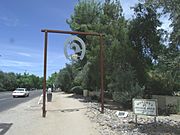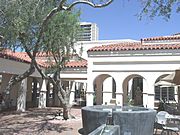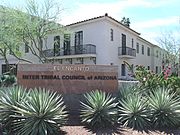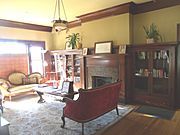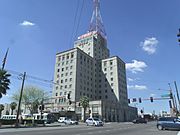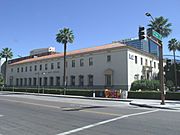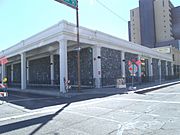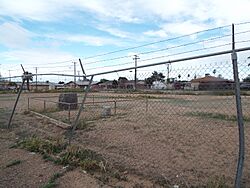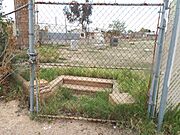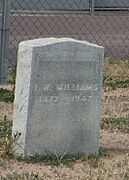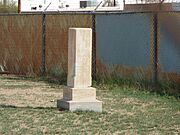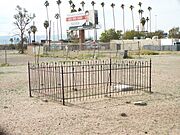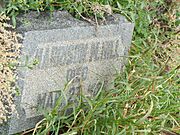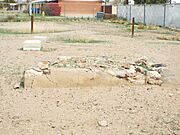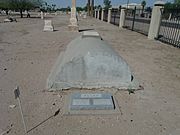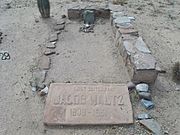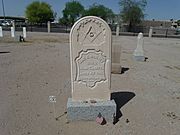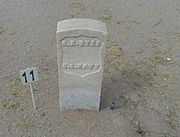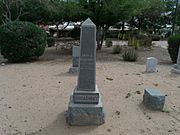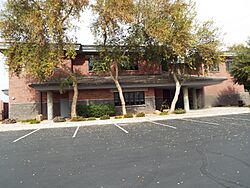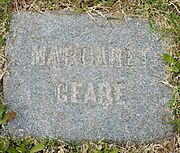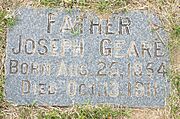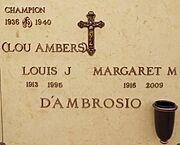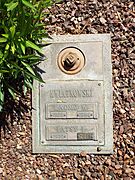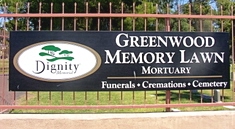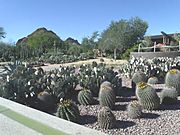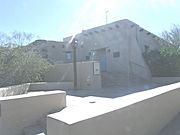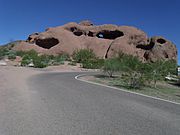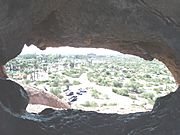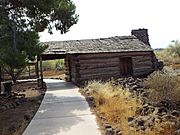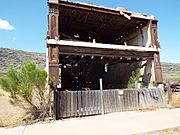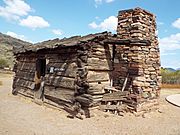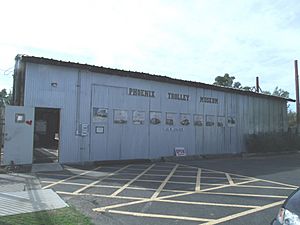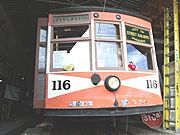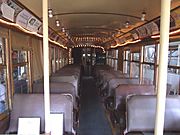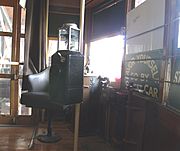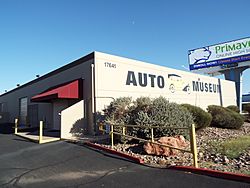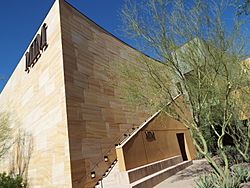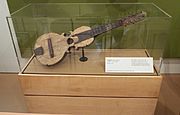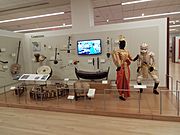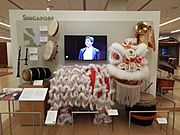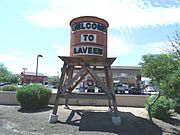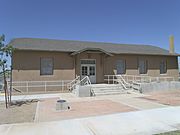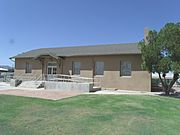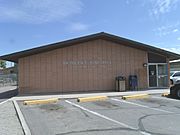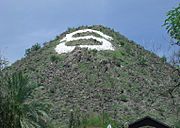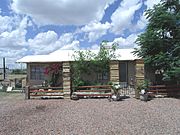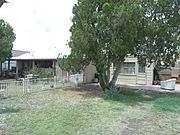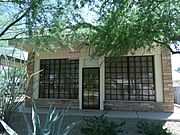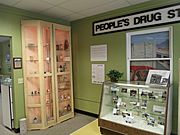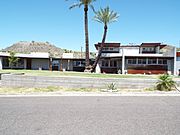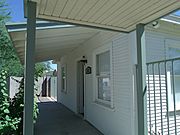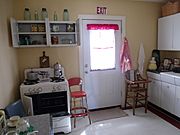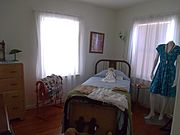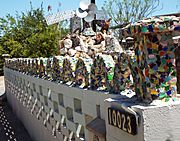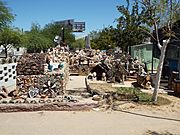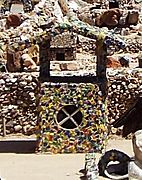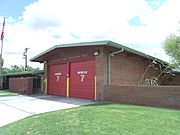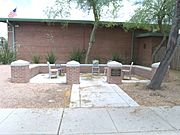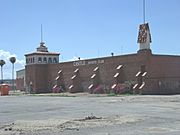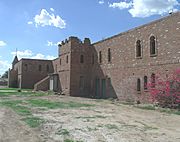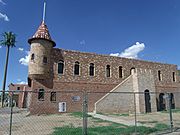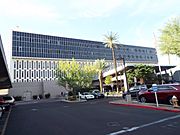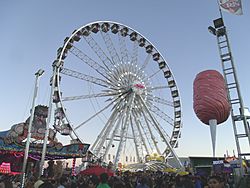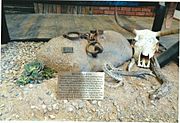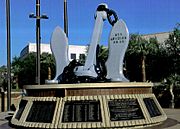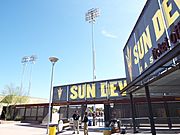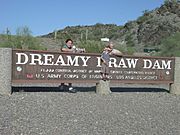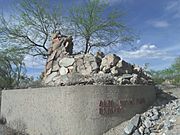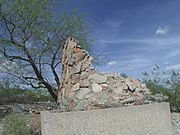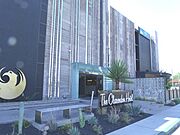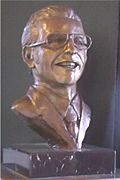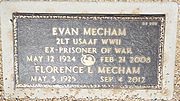List of historic properties in Phoenix facts for kids
Quick facts for kids
List of historic properties
in Phoenix, Arizona |
|
|---|---|
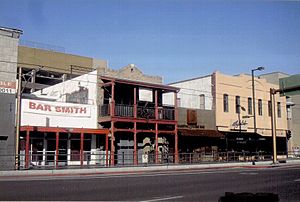
Historic Washington Street
|
|

Location in Maricopa County and the state of Arizona
|
This is a list, which includes photographic galleries, of some of the remaining historic structures and monuments, of historic significance, in Phoenix, Arizona, United States. Included are photographs of properties identified by the African, Asian and Hispanic historic property surveys of the City of Phoenix, focusing on the themes of history in Phoenix from 1870 to 1975.
This list however, is not limited to historical structures and monuments. Also listed are historical landmarks, some of which are listed in the National Register of Historic Places such as the Pueblo Grande Ruin and Irrigation Sites and the Deer Valley Rock Art Center. These contain the ruins of structures and artifacts of the Hohokams who lived within the modern Phoenix city area before the arrival of the settlers of non-Native American origin.
The abandoned Joint Head Dam and the early canals built by the early pioneers of European descent played an important role in the irrigation and development of Phoenix and its surrounding areas. Pictured is the ruins of the abandoned Joint Head Dam built in 1884. Also, pictured is the Grand Canal, the oldest canal in Phoenix which was built by the pioneers in 1877, and the Old Crosscut Canal, built in 1888.
Included in this list are the photographs of the final resting place of various notable people who are interred in Phoenix's historic cemeteries who were of historical importance to Phoenix and Arizona. According to the definition by the "Pioneers' Cemetery Association (PCA)" a "historic cemetery" is one which has been in existence for more than fifty years. Among the cemeteries listed is the abandoned Crosscut Cemetery which was established in 1870 and therefore, Phoenix's oldest cemetery and the Pioneer and Military Memorial Park, which is listed in the National Register of Historic Places.
Listed are some museums in Phoenix with the images of artifacts of historical importance. Such is the case of the Phoenix Trolley Museum where the historic Trolley Car #116 is showcased. Among the museums are the Martin Auto Museum, which showcases automobiles from 1886 onward and the Musical Instrument Museum.
Laveen and the Sunnyslope District are listed separately because these were two areas whose citizens wanted to proclaim the areas as independent towns, but whose areas were instead merged into the city of Phoenix.
Contents
- Phoenix
- Vanishing Phoenix
- Pueblo Grande Ruin
- The Joint Head Dam and canals
- Heritage Square
- Buildings and structures
- Houses of religious worship
- Educational institutions
- 19th century historic houses
- 20th century historic houses
- Historic African, Asian and Hispanic properties
- Arizona Biltmore Hotel
- Arizona State Capitol Museum
- Bennitt Mansion
- Mystery Castle
- Scorpion Gulch
- Squaw Peak Inn
- Westward Ho Hotel
- Wrigley Mansion
- Central Avenue Corridor
- Cemeteries
- Landmarks
- Museums
- Laveen
- Sunnyslope District
- Miscellaneous
- See also
Phoenix
Phoenix is the capital, and largest city, of the U.S. state of Arizona. Phoenix was incorporated as a city in 1881, after being founded in 1867 near the Salt River close to its confluence with the Gila River. The city has numerous historic properties which have been listed in the National Register of Historic Places. There are also 33 landmarks and attractions within Phoenix that are claimed to represent the best features of the city. These have been designated as "Phoenix Points of Pride" and/or are listed in the Phoenix Historic Property Register. The Phoenix Historic Property Register, was established in 1986. It is the city's official listing of the historic and prehistoric properties that have been deemed worthy of preservation. Some of these properties are listed in both the National Register of Historic Places and in the Phoenix Historic Property Register.
Historic Heritage Square is part of the Heritage and Science Park on the east end of downtown. It encompasses the only remaining group of residential structures from the original town site of Phoenix. The images of these properties with a short description of the same are included.
Vanishing Phoenix
According to Robert A. Melikian, author of the book Vanishing Phoenix, Phoenix's preservation office does not have the ability to deny a demolition permit. Therefore, the owner of a property, listed either in the National Register of Historic Places or the Phoenix Historic Property Register, may demolish the historical property. Entire neighborhoods, such as Golden Gate, where members of the minority communities lived have been razed. Both the residence of former Territorial Governor Joseph Kibbey located at 1334 E. Jefferson St. which served as the home and medical practice of Dr. Winston C. Hackett, the first African-American physician in Arizona and the building located at 1342 E. Jefferson St. where Hackett founded the Booker T. Washington Memorial Hospital were demolished. The historic St. James Hotel is an example of a building listed in the National Register of Historic Places which will be demolished, despite the protests of preservation groups, to make way for a VIP parking lot for the Phoenix Suns season ticket holders. Among the properties which are listed in the National Register of Historic Places and which have been demolished are the following:
- Arizona Citrus Growers Association Warehouse-601 E. Jackson Street.
- Concrete Block House – 618-620 N. 4th Avenue.
- Higuera Grocery – 923 S. 2nd Avenue.
- Lightning Delivery Co. Warehouse-425 E. Jackson Street.
- Overland Arizona Co. – 12 N. 4th Avenue.
- Judge W. H. Stillwell House – 2039 W. Monroe Street.
- Clinton Campbell House – 361 N. 4th Avenue.
Some of the historic houses and buildings which are listed in the National Register of Historic Places and/ or the Phoenix Historic Property Register are also listed in the "enDangered Dozen Historic Places List," released by the Phoenix Historic Neighborhoods Coalition. These structures are prone to vandalism and the elements. Among the structures which are neglected and are at the highest risk of disappearing in the near future are the following:
- The Steinegger Lodge, built in 1889 and located at 27 E. Monroe St.
- The William R. Norton House, built in 1895 and located at 2222 W. Washington St.
- The Charles Pugh House, built in 1897 and located at 356 N. Second Avenue / 362 N. Second Avenue. (The 356 address is how the records show the house today. It was listed as 362 in older records.)
- The Louis Emerson House, built in 1902 and located at 623 N. Fourth St.
- The Concrete Block Bungalow, built in 1908 and located at 606 N. 9th St.
- The Leighton G. Knipe House, built in 1909 and located at 1025 N. 2nd Avenue.
- The Sach's-Webster Farmstead House, built in 1909 and located in the Northwest corner of 75th Avenue and Baseline.
- The Sarah Pemberton House, built in 1920 and located at 1121 N. 2nd St.
- Mrs. Neal House, built in 1920 and located at 102 East Willetta Street.
Pueblo Grande Ruin
The Pueblo Grande Ruin is the remains of a 450 BC prehistoric Hohokam village. For unknown reasons the site was abandoned by 1450 AD. These are some of the ruins of the Hohokam structures which were unearthed and which are situated in the Pueblo Grande Museum & Archaeological Park.
- Historic Pueblo Grande Ruins in Phoenix, Arizona
Listed in the National Register of Historic Places
-
The Pueblo Grande Ruin Museum is located at 4619 E. Washington St. in Phoenix, Arizona. The ruins are listed in the National Register of Historic Places reference #66000184.
The Joint Head Dam and canals
When the pioneers of European descent settled in Phoenix, the area was mainly desert. Settlers such as Jack Swilling were inspired by the ancient canals of the Hohokam. The pioneers soon began to dig ditches to carry water from the Salt River which would irrigate their farms. Eventually, canal building companies, such as the Arizona Canal Company, which was formed in December 1882, were organized and built the current canals in the area. The Joint Head Dam was built in 1884, where Jack Swilling dug his ditch, known as the "Swillings Ditch", and where the Salt River are located. The dam served the Grand Canal (built 1878) and eventually the Old Crosscut Canal (built 1888). The abandoned Joint Head Dam has been determined to be eligible for inclusion in the National Register of Historic Places under criterion "A" because of its association with the locally important history of reclamation and therefore, is a Section 4 (f) resource.
- Joint Head Dam, the Grand Canal and the Old Crosscut Canal
Heritage Square
Phoenix's Heritage Square is located in what once was block 14 of the original townsite of Phoenix. The square dates back to the Victorian era of the late 1800s. The townsite was listed in the National Register of Historic Places on November 7, 1978, reference: #78000550. The Dr. Roland Lee Rosson House (1895), now a Victorian-period historic house museum, and Baird Machine Shop (1920), which are individually listed in the National Register of Historic Places, are also located in the historic square.
- Historic Phoenix Heritage Square
Buildings and structures
This section includes historical buildings which are listed either in the National Register of Historic Places or in the Phoenix Historic Property Register. The oldest of these, which is still standing and in use, is the "Fry's Building" which was built in 1885. The oldest hotel, which was completed in 1893, and is still in use today is the "Windsor Hotel".
Also, included in this section are historic structures such as the "Heard Ranch Grain Silos", listed in the PHPR plus, the Arizona State Fair Grandstand which was built in the early 1900s, the "17th Avenue Underpass" and the "Central Avenue Underpass", both which are eligible to be included in the National Register of Historic Places.
- Historic buildings in Phoenix, Arizona
(NRHP = National Register of Historic Places)
(PHPR = Phoenix Historic Property Register)
-
What remains of the Phoenix Bakery building. The structure was built in 1881 and was originally located at 7 West Washington Street. The building was donated to the Pioneer Living History Museum in Phoenix. In 2019, the bakery was moved and reassembled at the Phoenix Zoo.
-
The Steinegger Lodging House. The now abandoned structure was built in 1889 and listed in the National Register of Historic Places, reference: #86001369 on June 19, 1986. It was also known as the Alamo Hotel, St. Francis Hotel and the Golden West Hotel. It is located in 27 E. Monroe St. The Steinegger Lodging House was demolished on July 13, 2020.
-
The Windsor Hotel, originally known as the 6th Avenue Hotel, The hotel was completed in 1893 and is located at 546 W. Adams St. The hotel is listed in the National Register of Historic Places, reference: #85002041.
-
The Del Monte Market built in 1908 and located at 2659 W. Dobbins Road in South Mountain Village, an urban village within the city of Phoenix. It is the oldest continuously operating market in the state. Designated as a landmark with Historic Preservation-Landmark (HP-L) overlay zoning (Phoenix Historic Property Register).
-
The Swindall Tourist Inn was built in 1913 and is located at 1021 E. Washington St. Prior to 1964, public accommodations in Phoenix and Arizona were segregated. African Americans were not allowed to stay in the hotels in downtown Phoenix. The structure, which is listed in the National Register of Historic Places, reference: #95001081, is the only known surviving African-American boarding house in Phoenix.
-
The Luis Lugo Bakery, also known as "La Patellera", was built in 1917 and is located at 415 W. Sherman St. This structure is one of the earliest Hispanic commercial properties in Phoenix. Designated as a landmark with Historic Preservation-Landmark (HP-L) overlay zoning (Phoenix Historic Property Register).
-
The Tovrea Land and Cattle Co. Administration Building / Stockyards Restaurant is located at 5009 E. Washington St. In 1919, Edward A. Tovrea, the "Cattle Baron," opened his Phoenix packing house west of 48th Street and Van Buren to support his growing beef operations. The Tovrea Land and Cattle Co. had grown to nearly 40,000 head of cattle secured by 200 acres of cattle pens, making it the world's largest feedlot. In 1947, The Stockyards Restaurant officially opened and quickly became a favorite gathering place for cattlemen, bankers and politicians. Although cattle fortunes faded in the late 1950s and pens slowly gave way to urban growth, the popularity of Arizona's Original Steakhouse remained intact. The property was listed in the Phoenix Historic Property Register in March 2004.
-
The Cole Mansion and Baker House were built in the 1920s and are located at 1418 N. Central Avenue in Phoenix. The Cole family purchased the Baker house and in 1940 connected both houses with a building in between. The structure has been occupied by the SpaghettI Factory Restaurant since 1996. It is listed on the Phoenix Historic Property Register.
-
The Constable Ice and Fuel Co. building (now known as The Ice-house) was built in 1920 and is located at 429 W Jackson St. Before refrigeration ice was stored in this building. The Ice-house is located in the historic original townsite of the city of Phoenix. The building is now a cultural center devoted to promoting the Arts and humanitarian causes. Designated as a landmark with Historic Preservation-Landmark (HP-L) overlay zoning. The building was listed in the National Register of Historic Places September 4, 1985, reference: #85002074.
-
The Heard Building was built in 1920 and is located at 112 N. Central Avenue. It was Phoenix's first skyscraper. The building, which was listed in the National Register of Historic Places on September 4, 1985, reference: #85002059, was featured in Alfred Hitchcocks 1960 film "Psycho".
-
The Wing F. Ong Grocery Store located at 1246 E. Jefferson St. and built in 1925. Wing F. Ong ran for the state House of Representatives as a Democrat in 1946 and was elected, the first Chinese American in the country to achieve such status. Over the course of his career, he was elected twice to the state House and once to the state Senate.
-
Western Wholesale Drug Company Warehouse built in 1925 and located at 101 E. Jackson St. The structure is owned by rock legend Alice Cooper and now houses the Alice Cooperstown Restaurant. Designated as a landmark with Historic Preservation-Landmark (HP-L) overlay zoning (PHPR).
-
The San Carlos Hotel, also known as Hotel San Carlos, was built in 1925 and is located at 202 N. Central Avenue. Mae West, Clark Gable, Carole Lombard, Marilyn Monroe and Gene Autry are among the celebrities who at one time stayed at the San Carlos. The hotel was listed in the National Register of Historic Places in 1983. Reference number 83003498.
-
The Gold Spot Shopping Center built in 1925 and located at 1001 N. 3rd Avenue. The building served as a Shopping Center and Grocery from 1925 to 1983. Now serves as a Marketing Center. The building is in the Roosevelt Historic District which was listed in the National Register of Historic Places on November 30, 1983, reference #83003490.
-
Historic Old Phoenix City Hall built in 1928 and located at 17 S. Second Avenue. This structure served as the Phoenix's City Hall until 1994 when the a new building was completed to serve as such. Designated as a landmark with Historic Preservation-Landmark (HP-L) overlay zoning. Listed in the Phoenix Historic Property Register.
-
Maricopa County Courthouse built in 1928. In this court house the trial of infamous Winnie Ruth Judd, a.k.a. "The Trunk Murderess", was held. The historic "Miranda rights" were established in this court after the arrest of Ernesto Miranda. Both Judd and Miranda were incarcerated in the jail located on the sixth floor. Listed in the National Register of Historic Places.
-
Phoenix-Building-Maricopa County Courthouse Jail-1929-2.jpg
Maricopa County Jail where Judd and Miranda were once incarcerated.
-
Luhrs Tower built in 1929 and located at 45 W. Jefferson St. The Luhrs Tower appeared in the background of a scene from the 1960 film Psycho in which the character Marion Crane (played by Janet Leigh) crossed the street with the deposit she was supposed to make for her boss. Listed in the National Register of Historic Places, reference: #85003559
-
The Heard Museum building was built in 1929 and is located at 2301 N. Central Avenue / 22 E. Monte Vista Road. Maie Heard added quality artworks to the collection and worked closely with the board of trustees to direct the activities of the museum. She also oversaw the programming activities of the museum, approving speakers and insuring appropriate publicity was available. It was listed in the Phoenix Historic Property Register in August 1992.
-
The Heard Ranch Grain Silos were built in 1930 and are located within the golf course of the Legacy Resort in the vicinity of 30th Street and Vineyard Road. The ranch belonged to businessman Dwight B. Heard, who is given much of the credit for the Arizona Republic newspaper (of which he was publisher), the Heard Museum and the development of the vital irrigation canals and the Arizona cattle industry. The property was listed in the Phoenix Historic Property Register in March 1993.
-
This location which once housed the Living Room Lounge was built in 1930 and is located at 4007 E. Camelback Road in Phoenix. The building housed the Silver Poodle Cocktail Lounge prior to 1968, when boxing welterweight Tony DeMarco became the owner of the property and established what he called the Living Room Lounge. DeMarco no longer owns the property which now belongs to the U-Haul Co.
-
The Wastewater Treatment Plant Control Building was built in 1931 and is located at 2301 W. Durango St. The structure is now within the confines of the Arizona Department of Transportation District whose address is 2140 W. Hilton. It was listed in the Phoenix Historic Property Register in October 1992.
-
The Arizona Army National Guard Arsenal raw adobe building was constructed in 1936 and is located at 5636 E. McDowell Rd. It served as the National Guard arsenal building until WW II when it was converted into a maintenance shop for the German prisoners of war who were held in a camp located in what is now the Papago Park Military Reservation. The building now houses the Arizona Military Museum. The building was listed in the National Register of Historic Places March 31, 2010, reference: #10000108.
-
The Hunt Bass Hatchery Caretaker's House was built in 1936 and is located in the Phoenix Zoo grounds at 455 N. Galvin Parkway. Following the Great Depression, Governor Hunt (Arizona's first elected governor) commissioned a bass fish hatchery to be established in the Papago Park of Arizona during 1932. The property was listed in the National Register of Historic Places on January 23, 2003, reference: #02001723.
-
The Squaw Peak Inn was built in 1937 and is located at 4425 Horseshoe Road close to the east end of Squaw Peak Mountain in Phoenix. Among celebrities who have stayed in or visited the Inn, which was originally named Squaw Peak Ranch, are Dick Powell, June Allyson and Mamie Eisenhower. It served as the vocal point for the 1987 made-for-TV movie Probe: Plan Nine from Outer Space. The Inn was used as a backdrop during the interview made to Phoenix Suns Charles Barkley by ABC's prime Time Live on May 27, 1993. On January 12, 1995, the property was listed in the National Register of Historic Places, reference: #94001537.
-
The Webster Auditorium building was constructed in 1939 and is located inside the compounds of the Desert Botanical Garden at 1201 N. Galvin Parkway. The auditorium is named after Gertrude Webster. On June 13, 1990, the National Park Service certified Webster Auditorium as a national historic site. It was listed in the National Register of Historic Places on May 1, 1990, reference: #9000823.
-
The only remaining courtyard of the Matthew Henson Public Housing Project with the original houses which have been preserved from demolition. The housing project was built in 1940 and provided affordable housing for the African-American community. The Matthew Henson Public Housing Project district is located on the west side of Seventh Avenue just south of the Sherman Street alignment. It was named as a historic district by the Phoenix Historic Property Register in June 2005.
-
The Good Shepherd Home for Girls structure was built in 1942 and is located near the northeast corner of Northern and 19th Avenues. The home for girls closed in 1981 and is now a commercial property. The owners have kept the main architectural features intact. Designated as a landmark with Historic Preservation-Landmark (HP-L) overlay zoning. It was listed in the Phoenix Historic Property Register
-
The Progressive Builders Association Building was built in 1953 and is located at 2019 E. Broadway Road. The Progressive Builders Association built homes in downtown Phoenix, giving many African Americans their first opportunity to buy a brand-new home. In 1945, members of the community met at the First Institutional Baptist Church and formed the Progressive Builders Association. It was listed as historic by the Phoenix African-American Survey and listed in the Phoenix Historic Property Register in June 2005.
-
The Paris Laundry and Dry Cleaning Building was built in 1957. It is located 4130 N. 7h Avenue. This building was designed Googie style. Googie architecture is a form of modern architecture influenced by the Space Age and the Atomic Age. The building is considered historical by the Phoenix Historic Preservation Office.
-
The Phoenix Towers were built in 1957 and are located at 2201 N. Central Avenue. Phoenix Towers was built as a resident-owned cooperative community, Phoenix Towers is now considered an outstanding example of mid-century architecture and was listed in the National Register of Historic Places on January 2, 2008, reference #07001334.
-
Front view of the Phoenix Towers. The towers were built in 1957 and are located at 2201 N. Central Avenue. Phoenix Towers was built as a resident-owned cooperative community, Phoenix Towers is now considered an outstanding example of mid-century architecture and was listed in the National Register of Historic Places on January 2, 2008, reference #07001334.
-
The 300 Bowl building, which now houses the AMF Christown Lanes, was built in 1960. It is located 1911 W. Bethany Home Road. The three point roofline pegs this building as Googie architecture in style. Googie architecture is a form of modern architecture influenced by the Space Age, and the Atomic Age. The building is considered historical by the Phoenix Historic Preservation Office.
-
Arizona Veterans Memorial Coliseum built in 1965 and located at and located at 1826 W. McDowell Road. The coliseum served as the home of the Phoenix Suns from 1968 to 1992. The Monkees performed there in 1967 and so did Elvis Presley in 1970 and 73.
-
Different view of the Arizona Veterans Memorial Coliseum. On February 2, 1980, boxing Hall of Famer, Salvador Sanchez won the WBC World featherweight title when he beat Danny Lopez. Both Pope John Paul II (Sept. 14, 1987) and Mother Teresa (1989) made appearances there. Among the U.S. presidents that have visited the coliseum are Richard Nixon and Barack Obama.
Houses of religious worship
Many of the historic houses of religious worship, such as the "First Presbyterian Church" (1892), are listed in the National Register of Historic Places. Others, such as the "Tanner Chapel A.M.E. Church" (1929), have been designated historic by the Phoenix Historic Property Register. The Tanner Chapel A.M.E. Church, one of the oldest African-American churches in the state, is the only Arizona church where civil rights leader Martin Luther King Jr. is known to have given a sermon. Houses of religious worship such as the "First Mexican Baptist Church" (1920), Phoenix's oldest Hispanic church, are recognized as historic by surveys, as in the case of the Hispanic American Historic Property Survey of the City of Phoenix.
- Historic Houses of religious worship in Phoenix, Arizona
(NRHP = National Register of Historic Places)
(PHPR = Phoenix Historic Property Register)
-
The Temple Beth Israel (1922)/ First Chinese Baptist Church (1957)/ Iglesia Bautista Central (1981) was built in 1922 and is located at 122 E. Culver Street. It was Phoenix's first synagogue and the building later served as Phoenix's First Chinese Baptist Church and from 1981 to 2002, the Hispanic community as the Iglesia Bautista Central. It was listed in the National Register of Historic Places on February 22, 2011, reference #11000043.
-
The First Baptist Church was built in 1923 and is located at 302 W. Monroe Street. The First Baptist Church is an Italian Gothic design by Phoenix architectural firm Fitzhugh & Byron. It was badly damaged by fire in 1980 and has been abandoned since. the structure is listed in the National Register of Historic Places.
-
The Phoenix LDS Second Ward Church was built in 1929, and is the oldest LDS chapel in Phoenix. It was used by the "Phoenix Arts Council" for several years before being sold to the "Great Arizona Puppet Theater" in 1996. The building is located at 302 W Latham Street. It was added to the "National Register of Historic Places" in 1983. Reference number 83003492.
-
The First Missionary Church was built in 1928 and is located at 902 E. McKinley in Phoenix's historic Garfield neighborhood. The architecture of the structure is that of Mission Revival. It is designated as a landmark by the Historic Preservation-Landmark (HP-L) overlay zoning. It is listed in the Phoenix Historic Property Register.
-
The Brophy College Chapel was built in 1928 and is located at 4701 N. Central Avenue. The Chapel was donated by Mrs. William Henry Brophy in memory of her husband. The Spanish Colonial chapel was built by the students of Brophy College. It was listed in the National Register of Historic Places on August 10, 1993, reference #93000747.
-
The Tanner Chapel A.M.E. Church, named after Bishop Benjamin T. Tanner, was built in 1929 and is located at 20 S. 8th Avenue. it is the oldest African-American congregation in Arizona. Designated as a landmark with Historic Preservation-Landmark (HP-L) overlay zoning. It is listed in the Phoenix Historic Property Register.
-
The Mennonite Church Meetinghouse was built in 1946 at 9835 N. 7th Street in what was then Sunnyslope. Sunnyslope later became part of Phoenix. In 1949, a new church was erected beside it. The older building was then used as a Christian day school and Sunday school. The church is listed in the Phoenix Historic Property Register.
-
The Lucy Phillips Memorial C.M.E. Church was built in 1947 and is located at 1401 E. Adams Street. The church was built by the African-American community in Phoenix. It was named Lucy Phillips Memorial C.M.E. Church in honor of the wife of the first presiding bishop, the Rev. Charles Henry Phillips. The church was listed in the Phoenix Historic Property Register in June 2005.
-
The Pavilion of Light of the Phoenix First Assembly of God, or simply "Phoenix First", is an Assemblies of God megachurch. The structure was built in the 1980s and is located at 13613 N. Cave Creek Road. As of 2011, it was the second largest Assembly of God church in the U.S. with an average Sunday attendance of 10,000.
Educational institutions
The first school in Phoenix was established in 1873. It was known as the Little Adobe School and it was located in 202 N. Central Avenue where the San Carlos Hotel currently stands. Schools were segregated then and therefore, so were many of the historic schools on this list. The Phoenix Indian School was established in 1891 under the federal "assimilation" policy which sought to regimentalize and culturally exterminate Native American students. African-American students were only allowed to attend racially segregated schools such as the Dunbar School which was built in 1925, the Phoenix Union Colored High School (Later renamed George Washington Carver High School) built in 1926, and the Booker T. Washington Elementary School built in 1928.
- Historic educational institutions in Phoenix, Arizona
(NRHP = National Register of Historic Places)
(PHPR = Phoenix Historic Property Register)
-
The Arizona Academy North and South Halls were built in 1928 and are located at 1325 N. 14th Street. The former academy is now known as the Stepping Stone Place. The North Hall is addressed as 1307 and the South Hall as 1305. Both towers were listed in the National Register of Historic Places in 1993, ref.: #93000813.
19th century historic houses
Some of these houses meet the National Register criteria for evaluation. The quality of significance in American history, architecture, archeology, engineering, and culture is present in districts, sites, buildings, structures, and objects that possess integrity of location, design, setting, materials, workmanship, feeling, and association and that are associated with the lives of persons significant in Phoenix's past. The following prominent people who at one time or another lived in Phoenix and whose houses are listed here are:
- Clinton Campbell, a locally prominent builder who worked in Phoenix. His house however, was demolished in 2017.
- Phillip "Lord" Darrell Duppa. Duppa is credited with naming "Phoenix" and "Tempe" and the founding of the town of New River.
- Burgess A. Hadsell, Hadsell, together with William J. Murphy, promoted the temperance colony of Glendale, Arizona in the western Salt River Valley.
- William John Murphy. Murphy created the Arizona Improvement Company in 1887 and bought land in areas that would eventually become the towns of Peoria and Glendale of Arizona.
- William R. Norton. Norton founded the Sunnyslope subdivision of Phoenix and designed the Carnegie Library, the city's first library, and the Gila County Courthouse in Globe, Arizona.
- William Osborn, one of Phoenix's first homesteaders.
- Judge Charles A. Tweed. Judge Tweed was appointed an Associate Justice to the Arizona Territorial Supreme Court. Tweed then moved to Arizona Territory and was appointed to serve two terms as an Associate Justice of the Arizona Territorial Supreme Court.
- Historic houses built in the 19th century in Phoenix, Arizona
(NRHP = National Register of Historic Places)
(PHPR = Phoenix Historic Property Register)
-
The Jones-Montoya House, located at 1008 E. Buckeye Road, was built in 1879 and is one of Phoenix's oldest houses. The house is listed as historic by the Phoenix Historic Property Register. This was the homestead house of "Lord" Darrell Duppa, an Englishman who is credited with naming "Phoenix" and "Tempe" and the founding of the town of New River. Duppa later sold the adobe house to John Britt Montgomery. Designated as a landmark with Historic Preservation-Landmark (HP-L) overlay zoning. The house is listed as historic by the Phoenix Historic Property Register.
-
The Judge Charles A. Tweed House, built in 1880 and located at 1611 W. Filmore St. On April 14, 1870, Judge Tweed was appointed an Associate Justice to the Arizona Territorial Supreme Court. Tweed then moved to Arizona Territory and was appointed to serve two terms as an Associate Justice of the Arizona Territorial Supreme Court. The house is listed as historic by the Phoenix Historic Property Register.
-
The Eyrich-Kohl House was built in 1885 and is located at 1015 Woodland Avenue. Eyrich was a German immigrant who moved to Arizona in 1875. According to the Phoenix Historical Society, Eyrich was a plumber who in the past had served as a cavalryman, "Indian fighter," prospector, miner, hotel and café employee and proprietor. Kohl, cattle rancher, lived in the house from 1917 to 1920. The house is listed in the National Register of Historic Places. Reference #94001530.
-
The Burgess A. Hadsell House was built in 1893 and is located at 1001 E. Fillmore St. Hadsell, together with William J. Murphy, promoted the temperance colony of Glendale, Arizona in the western Salt River Valley. The house was listed in the National Register of Historic Places on January 12, 1995, reference #94001531.
-
The Clinton Campbell House belonged to Clinton Campbell, a locally prominent builder in Phoenix. It was built in 1895 and was located at 361 N. 4th Avenue. The house was listed in the National Register of Historic Places on January 12, 1995, reference #94001526. The historic house was demolished on September 15, 2017, by its owners.
-
The William R. Norton House was built in 1895 and is located at 2222 W. Washington Street. Norton founded the Sunnyslope subdivision of Phoenix and designed the Carnegie Library, the city's first library, and the Gila County Courthouse in Globe, Az. The house is listed as historic by the Phoenix Historic Property Register.
-
The William J. Murphy House was built in 1895 and is located at 7514 N. Central Avenue. William J. Murphy created the Arizona Improvement Company in 1887 and bought land in areas that would eventually become the towns of Peoria and Glendale. The house is listed as historic by the Phoenix Historic Property Register.
-
The O.C. Thompson House was built in 1897 and is located at 850 N. 2nd Avenue. The building was converted to apartments long after O.C. Thompson and family moved out and now houses several office spaces. Designated as a landmark with Historic Preservation-Landmark (HP-L) overlay zoning. The house is listed as historic by the Phoenix Historic Property Register.
20th century historic houses
The following prominent people who at one time or another lived in Phoenix and whose houses are listed here are:
- Dr. Charles "Charley" Borah, an American athlete, who won the gold medal in the 4 × 100 m relay at the 1928 Summer Olympics.
- Jorgine Slettede Boomer, the widow of Lucius Boomer, a successful hotelier. Her house was designed by Frank Lloyd Wright.
- Dr. George Brockway, a physician who served as the Pinal County Superintendent of Public Health as well as two terms as Mayor of Florence.
- L. Ron Hubbard, the founder of the Church of Scientology religion.
- John McCain, a statesman who served as a United States Senator from Arizona from January 1987 until his death. He previously served two terms in the United States House of Representatives and was the Republican nominee for President of the United States in the 2008 election.
- Colonel James McClintock, whose full name was "James Henry McClintock", was a veteran of the United States Army who served in the Spanish–American War. He moved to Arizona and served as state historian from 1917 through 1922. He was also one of the founders of the Arizona Republican newspaper, now The Arizona Republic.
- Dr. James C. Norton, the territorial veterinarian.
- Wing F. Ong, the first person born in China to be elected to a state legislative house.
- Henry E. Pierce, who served as County Assessor during the 1920s and was secretary to Governor John C. Phillips from 1929 until 1932. He was chairperson of the Maricopa County Republican Central Committee. In addition to his political activities, Pierce was a partner in the real estate firm of Jacobs & Pierce.
- Aubrey and Winstona Aldridge. Winstona Hackett was the daughter of Dr. Winston Hackett the first African-American doctor in the area, and her husband Aubrey Aldridge.
- William Wrigley, Jr., the Chewing-gum magnate whose mansion in Phoenix is known by some people as "La Colina Solana".
Historic African, Asian and Hispanic properties
The City of Phoenix conducted various historic property surveys focusing on the themes of African, Asian and Hispanic history in Phoenix from 1870 to 1975. The purpose of the surveys was to identify the number and locations of minority associated historic properties citywide and to document their significance to their community. The surveys were funded by the Phoenix Historic Preservation Bonds funds as well as a Certified Local Government grant received from the National Park Service through the Arizona State Historic Preservation Office. While the National Register of Historic Places Criteria is only concentrated on the properties of these communities prior to 1955, the study included in the surveys take into consideration the significance of the struggle for civil rights and equality. Therefore, the properties which were involved in ending segregation in Phoenix are also included.
The areas covered in the African American Historic Property Survey are 1. East – the region south of Van Buren Avenue to the Southern Pacific Railroad tracks, east of Central Avenue to 24th Street; 2. West – the region south of Grant Avenue to the Salt River, west of 7th Avenue to 19th Avenue; and 3. South – the region south of the Salt River to Southern Avenue, east of 16th Street to 28th Street.
The areas covered in the Asian American Historic Property Survey are spread throughout Phoenix and not concentrated in one area. The concentration of the areas depends on the nationality from which they are descended, such as Chinese, Japanese, Filipino and Asian Indian.
The areas covered in the Hispanic American Historic Property Survey are the regions south of the Southern Pacific Railroad tracks to the Salt River, east of Central Avenue to 24th Street; west of Central Avenue to 27th Avenue and south of the Salt River to Baseline, east to 48th Street and west to 35th Avenue. One of the structures considered as iconic is the Sacred Heart Church which is located in 920 S. 17th St. The church was built in 1900 in what was once a Hispanic neighborhood called "Golden Gate". The City of Phoenix forced the residents of the community in question to move and demolished the entire neighborhood. The reason given for this act was that the city needed the land to expand Sky Harbor Airport. The church was added to National Register of Historic Places on March 20, 2012. Reference number 12000124.
The following prominent people who at one time or another lived in Phoenix and whose houses are listed here are:
- Judge Hazel Burton Daniels – Daniels was the first African American elected to the Arizona legislature and was the first African-American municipal judge in Phoenix, serving as such from 1965 to 1971.
- Dr. Lincoln Johnson Ragsdale Sr. and Eleanor D. Ragsdale – The Ragsdales were influential leader in the Phoenix Civil Rights Movement. They played an instrumental role in the reforms made of voting rights and the desegregation of schools, neighborhoods and public housing.
- Charles Smith – Smith was the only African-American blacksmith in Phoenix in the early 1920s.
- John Ford Smith – Smith is the only Arizonan known to have played in the national Negro Baseball Leagues. In 1941 Smith joined the Kansas City Monarchs, a team that won its third straight pennant in the Negro American League that year. Smith worked for Phoenix Union High School, served as director of Eastlake Park, and eventually became assistant vice president of human resources at the Arizona Bank. He was active in civil rights issues and served as director of the Arizona Civil Rights Commission.
- Travis L. Williams – Williams was one of the founders of Williams and Jones Construction Company which built homes primarily in South Phoenix. From 1964 to 1989 he worked for the City of Phoenix where he retired as the head of the Human Resources Department. He was a member of several service and civic organizations including the NAACP and Southminster Presbyterian Church.
- Historic African-American Properties
(including buildings, schools, churches and homes)
National Register of Historic Places=(NRHP)
-
Eastlake Park is bounded by 15th, 16th, Jefferson and Jackson streets. The period of historic significance of this park was from 1890 to 1949. In 1911, Booker T. Washington spoke there during the celebration called the Great Emancipation Jubilee. W. E. B. DuBois also addressed a crowd in the park. The park was listed in the Phoenix Historic Property Register in June 2009.
-
The Swindall Tourist Inn was built in 1913 and is located at 1021 E. Washington Street. Prior to 1964, public accommodations in Phoenix and Arizona were segregated: African Americans were not allowed to stay in the hotels in downtown Phoenix. The structure, which is listed in the National register of Historic Places ref. number 95001081, is the only known surviving African-American boarding house in Phoenix. It is also listed on the African American Historic Property Survey.
-
The Tanner Chapel A.M.E. Church, named after Bishop Benjamin T. Tanner, is located at 20 S. 8th Avenue. Built in 1929, it is the oldest African-American congregation in Arizona. Designated as a landmark with Historic Preservation-Landmark (HP-L) overlay zoning. It is listed in the Phoenix Historic Property Register (PHPR).
-
The W.A. Robinson House was built in 1935 and is located at 1314 East Jefferson Street. Robinson was the principal of Washington Carver High School, an African-American school. He was concerned about the effects which the desegregation of the schools may have on the African-American students. It is recognized as historical by the City of Phoenix African-American Survey.
-
Entrance of where the historic Matthew Henson Public Housing Project once stood. The Matthew Henson Public Housing Project was built in 1940 and provided affordable housing for the African-American community. The Matthew Henson Public Housing Project District is located on the west side of Seventh Avenue just south of the Sherman Street alignment. It was named as a historic district by the Phoenix Historic Property Register in June 2005.
-
One of the original houses in the courtyard of the Matthew Henson Public Housing Project. The house was built in 1940 and in a courtyard which has been preserved from demolition. The housing project was built in 1940 and provided affordable housing for the African-American community. The Matthew Henson Public Housing Project district is located on the west side of Seventh Avenue just south of the Sherman Street alignment. It was named as a historic district by the Phoenix Historic Property Register in June 2005.
-
This is the building where in 1944, Gordon Fritch established his Gordon Fritch Cafe. The cafe, which was a popular place among Phoenix's African Americans, is located at 1602 East Jefferson Street. Later, Reddey's Corner was established. "Reddey's Corner" was the oldest Drive-in Liquor Store in Phoenix. It is listed on the African American Historic Property Survey.
-
The St. John's Institutional Baptist Church was built in 1944 and is located in 1428 S. 13th Avenue. The Rev. L.J. Dunbar led St. John's Institutional Baptist Church, starting in 1941. Dunbar helped organized approximately 35 other Baptist churches in the state. He died in 1994 at the age of 91. It is listed as historic by the Phoenix African-American Survey.
-
The Geogie M. & Calvin C. Goode Bandshell was built in 1945 and is located in Eastlake Park at 1549 E. Jefferson St. In 1948 African American activist Claudia Jones spoke from the bandshell to a crowd of 1,000 people at Eastlake Park about equal rights for African Americans. The bandshell is named after African-American Geogie M. Goode, an author, educator and activist. She was married to Calvin C. Goode, who served a total of 22 years as a representative to the Phoenix, Arizona City Council. The bandshell is listed in the Phoenix Historic Property Register.
-
The Robert and Louise Phillips House was built in 1946 and is located at 4417 S. 19th St. In December 1946, Phoenix dentist Robert Phillips and his wife, Louise, created a subdivision called Carlotta Place. Both Dr. and Mrs. Phillips were involved in the school desegregation effort in the early 1950s, and Louise was president of the Maricopa branch of the NAACP until 1960. It was listed as historic by the Phoenix African-American Survey.
-
The William H. Patterson Elks Lodge No. 477 was built in 1946 and is located at 1007 S. Seventh Avenue. Built by the African-American community and named after William H. Patterson, who once was a Buffalo Soldier, in what once was a segregated Phoenix. Designated as a landmark with Historic Preservation-Landmark (HP-L) overlay zoning. It is listed in the Phoenix Historic Property Register.
-
The Lucy Phillips Memorial C.M.E. Church was built in 1947 and is located at 1401 E. Adams St. The church was built by the African-American community in Phoenix. It was named Lucy Phillips Memorial C.M.E. Church in honor of the wife of the first presiding bishop, the Rev. Charles Henry Phillips. The church was listed in the Phoenix Historic Property Register in June 2005.
-
The Mary McLeod Bethune School (Bethune Elementary School) was built in 1947 and is located at 1510 S. 15th Avenue. The Mary McLeod Bethune Elementary School is another segregated school opened by the Phoenix School District. It was built to provide for the rapidly expanding Black community on the west side of Phoenix. It is listed as historic by the Phoenix African-American Survey.
-
The Greater Friendship Missionary Baptist Church was built in 1949 and is located at 1901 E. Jefferson St. The Greater Friendship is one of several churches founded in the area in the 1940s. City of Phoenix historians call the building a modest Norman Revival-style of architecture, with a front parapet, gabled roof and two towers. It was listed as historic by the Phoenix African-American Survey.
-
The Higher Ground Church of God in Christ was built in 1949 and is located at 1302 E. Madison St. Later called Abundant Life Baptist Church, the property was purchased by Pilgrim Rest Baptist Church in 2004. No services are currently held here, but the building is used for youth groups, funerals and other Pilgrim Rest gatherings. It was listed as historic by the Phoenix African-American Survey.
-
The Dr. Lowell Wormley House was built in 1949 and is located at 1910 E. Broadway Road. Dr. Lowell Wormley was born in Washington, D.C., and studied medicine at Howard University Medical School. When he arrived in Arizona in the mid-1940s, he was one of only three African-American doctors in Phoenix. He was on the staff of both St. Joseph's and Good Samaritan hospitals. He opened his own practice in 1946 in the Midtown Medical Building, 1 N. 12th St., and practiced there until the early 1980s. In 1949, he and his wife, Olivia, built this home on East Broadway Road. The house was listed in the Phoenix Historic Property Register in June 2005.
-
The Aldridge House, also known as Aubrey and Winstona Aldridge House, is located at 1326 E. Jefferson St. and was built in 1950. It was the home of Winstona Hackett, daughter of Dr. Winston Hackett the first African-American doctor in the area, and her husband Aubrey Aldridge. Designated as a landmark with Historic Preservation-Landmark (HP-L) overlay zoning. It is listed in the Phoenix Historic Property Register (PHPR).
-
The Progressive Builders Association Building was built in 1953 and is located at 2019 E. Broadway Road. The Progressive Builders Association built homes in downtown Phoenix, giving many African Americans their first opportunity to buy a brand-new home. In 1945, members of the community met at the First Institutional Baptist Church and formed the Progressive Builders Association. It was listed as historic by the Phoenix African-American Survey, in the Phoenix Historic Property Register in June 2005 and in the National Register of Historic Places.
-
The Southminster Presbyterian Church was built in 1954 and is located at 1923 E. Broadway Road It was the only African-American Presbyterian church in Phoenix when it was founded in 1954. The Rev. George Benjamin Brooks, a Phoenix civil-rights leader, was the founding pastor. It was listed as historic by the Phoenix African-American Survey.
-
The Morrison E. Warren House was built in 1956 and is located at 2131 E. Violet Dr. Morrison E. Warren was the first African American elected to the Phoenix City Council (1966 to 1970). He also served as vice-mayor from 1972 to 1994. The property was listed as historic by the Phoenix African-American Survey.
-
The Calvin and Georgie Goode Duplex House were built in 1959 (1508) and 1959 (1510) and is located at 1508-10 East Jefferson Street. Calvin Goode served a Phoenix City Councilman for 22 years. His wife, Georgie Goode, was a Civil Rights leader and activist. It is recognized as historical by the City of Phoenix African-American Survey.
- Dea Hong Toy – Toy was born in China and moved to Phoenix in 1923. He was a successful merchant. Toy was among those in the Asian community of Phoenix who in 1938 founded the Chinese Chamber of Commerce to protect and promote their businesses.
- Wing F. Ong – Ong lived in a house in the rear of his grocery store which is listed here. He ran for the state House of Representatives as a Democrat in 1946 and was elected, the first Chinese American in the country to achieve such status. Over the course of his career, he was elected twice to the state House and once to the state Senate.
- Lee Jew – Jew was a Chinese merchant who owned the "Lee Jew Market" on E. Jefferson St. He was influential as a leader in the Phoenix Chinese community.
- Historic Asian-American Properties
(including buildings, schools, churches and homes)
National Register of Historic Places=(NRHP)
-
The K.S. Tang Grocery building was built in 1914 and is located at 901 Northwest Grand Avenue. The property was leased to Chinese grocers, Yung Yee Ghee from 1916 to 1920, and to K. S. Tang from 1928 to 1937. This property is recognized as historic by the Asian American Historic Property Survey. On October 1, 1985, the building was listed in the National Register of Places together with its neighbor, the Durand Grocery as Durand Grocery, ref. #85002891.
-
The Temple Beth Israel (1922)/ First Chinese Baptist Church (1957)/ Iglesia Bautista Central (1981) was built in 1922 and is located at 122 E. Culver St. It was Phoenix's first synagogue and the building later served as Phoenix's first Chinese Baptist Church and from 1981 to 2002, the Hispanic community as the Iglesia Bautista Central. It was listed in the National Register of Historic Places on February 22, 2011, reference #11000043.
-
The Dea Hong Toy House was built in 1954 and is located at 2222 East Pasadena Avenue. Toy was born in China and moved to Phoenix in 1923. He was a successful merchant. Toy was among those in the Asian community of Phoenix who in 1938 founded the Chinese Chamber of Commerce to protect and promote their businesses. This property is recognized as historic by the Asian American Historic Property Survey.
- Vincente Canalez – In 1945 Canalez was selected to serve as Maricopa County chairman to fight infantile paralysis, and served on the City of Phoenix's planning commission in the 1950s. He moved to the Arizona town of Buckeye in 1957, and served as mayor of Buckeye in 1960.
- Valdemar Aguirre Cordova – Cordova served as the first Mexican American Maricopa County Superior Court judge, from 1965 to 1967, and then appointed to a second term in 1976 by Governor Raul Castro.
- Jesus Franco – The Spanish-language newspaper, El Sol, emerged in 1938 under the leadership of Jesús Franco, who became a very well-known individual in the Mexican community.
- Albert and Mary Garcia – Albert Garcia was Arizona's first Hispanic Assistant Attorney General. María García was an activist for social issues.
- Placida Garcia Smith – Placida Garcia Smith founded the "Friendly House" in the mid-1920s as a two-room "community house" where classes in English, citizenship, hygiene and homemaking were taught to Mexican residents.
- Rudolf Zepeda – Zepeda was the first Hispanic official at Valley National Bank in the 1950s, serving as the vice-president for foreign trade.
- Adam Perez Diaz – In 1954, Diaz became the first Hispanic elected to the Phoenix City Council and also served as Vice-Mayor. President Bill Clinton appointed Diaz to the National Council on Aging
- Historic Hispanic-American Properties
(including buildings, schools, churches and homes)
National Register of Historic Places=(NRHP)
-
The Sotelo-Heard Cemetery was established in 1896 and is located at 1127 W Broadway Road. This is on the southeast intersection of 12th Avenue and Broadway Road. Hundreds of Mexican laborers and their children were buried near 12th Avenue and Broadway Road from the late 1880s to the 1920s. The cemetery received heavy use between 1896 and 1922 in a community where a majority of the residents were of Mexican descent and settled, farmed, or dug irrigation canals in the Lower Salt River Valley. Many were laborers on the Bartlett-Heard Ranch or other Anglo-owned ranches in the area. The cemetery was listed in the Phoenix Historic Property Register in October 2007. Throughout the years, grave robbers and kids trampled on the headstones and destroyed them. The site is in complete state of abandonment.
-
The Pete Romo House was built in 1913 and is located at 753 E. Pierce St. Pete Romo owned a butcher shop on Washington Street, near the Ramona Theater in the 1920s. This property is recognized as historic by the Hispanic American Historic Property Survey of the City of Phoenix. The house is part of the Garfield Historic District which is listed in the National Register of Historic Places, reference number: #10000325.
-
The Luis Lugo Bakery "La Patellera" was built in 1917 and is located at 415 W. Sherman St. This structure is one of the earliest Hispanic commercial properties in Phoenix. Designated as a landmark with Historic Preservation-Landmark (HP-L) overlay zoning. It is listed in the Phoenix Historic Property Register.
-
The Friendly House structure was built in 1900 and is located at 802 South 1st. Avenue. The Friendly House was established in 1922 by the Phoenix Americanization Committee presided by Placida Garcia Smith with the help of Mary Garcia to assist immigrants in transitioning their lives to Arizona. This property is recognized as historic by the Hispanic American Historic Property Survey.
-
The Placida Garcia Smith House was built in 1925 and is located at 111 W. Granada Rd. Placida Garcia Smith founded the "Friendly House", located at 802 S. 1st. Avenue, in the mid-1920s as a two-room "community house" where classes in English, citizenship, hygiene and homemaking were taught to Mexican residents. This property is recognized as historic by the Hispanic American Historic Property Survey. It is located in the Willo Historic District which was listed in the National Register of Historic Places on January 9, 1991, ref.: 90002099.
-
This is the Albert and Mary Garcia House located at 2201 N Dayton St. The house was built in 1930. Albert Garcia became Arizona's first Hispanic Assistant Attorney General, from 1937 until 1942. María Garcia stood out as a woman who courageously spoke up for social issues, even though she was an immigrant and carried a heavy accent. The house is in the Historic Coronado District which is listed in the National Register of Historic Places, reference: #86000206.
-
The Valdemar Aguirre Cordova House built in 1930 is located at 1917 W Monte Vista Rd. Cordova served as the first Mexican American Maricopa County Superior Court judge, from 1965 to 1967, and then appointed to a second term in 1976 by Governor Raul Castro. This property is recognized as historic by the Hispanic American Historic Property Survey.
-
Grant Park is bounded by 714 S. Second Avenue / 701 S. Third Avenue. Grant Park, created in 1934 as part of a WPA construction project, functioned as an important site for Mexican American children's recreation. The recreation programs were led by a recreation director, Laura McClelland, who was well-known in the community for her time and compassion for the area children. The park was listed in the Phoenix Historic Property Register in November 2007.
-
The Grant Park Pool building was built in 1944 as a result of the 1934 Civil Works Administration funding. It is located in the corner of Grant St. and 2nd Avenue. The Pool served the Hispanic community of Phoenix at a time when the usage of public swimming pools was segregated. Grant Park, where the pool is located, is listed in the Phoenix Historic Property Register.
-
The Jesus Franco House was built in 1940 and is located at 321 W. Portland Avenue. The Spanish-language newspaper, El Sol, emerged in 1938 under the leadership of Jesús Franco, who became a very well-known individual in the Mexican community. This property is recognized as historic by the Hispanic American Historic Property Survey of the City of Phoenix. The house is listed in the National Register of Historic Places as part of the Roosevelt Historic District reference number: #83003490.
-
The Rudolf Zepeda House was built in 1940 and is locate at 1310 W Palm Lane. Rudolf Zepeda, became the first Hispanic official at Valley National Bank in the 1950s, serving as the vice-president for foreign trade. The house is located in the Encanto Historic District which was listed in the National Register of Historic Places on February 16, 1984, reference #84000696.
-
The American Legion Post #41 , also known as the "Tony Souza-Ray Martinez Thunderbird Post #41", was built in 1945 and is located at 715 S. 3rd Avenue. This property is recognized as historic by the Hispanic American Historic Property Survey of the City of Phoenix. The building was listed in the Phoenix Historic Property Register in November 2007.
-
The Primera Iglesia Metodista (First Methodist Church) was built in 1947 and located at 701 S. 1st St. This property is recognized as historic by the Hispanic American Historic Property Survey of the City of Phoenix. It was designated as a landmark with Historic Preservation-Landmark (HP-L) overlay zoning. It is listed in the Phoenix Historic Property Register.
-
The Vincente Canalez House was built in 1951 and is located at 2627 N Evergreen St. Canalez co-owned the Ramona Pharmacy with future Arizona governor Bob Jones. Canalez later became involved in the Democratic Party as a precinct committeeman. In 1945 he was selected to serve as Maricopa County chairman to fight infantile paralysis, and served on the City of Phoenix's planning commission in the 1950s. He moved to the Arizona town of Buckeye in 1957, and served as mayor of Buckeye in 1960. This property is recognized as historic by the Hispanic American Historic Property Survey.
-
This historic building is the Santa Rita Center (also known as Santa Rita Hall). It is located at 1017 E. Hadley Street between 10th Street and 10th Place. It was here where Arizona native Cesar Chavez, the hero of farm workers, began his 24-day hunger strike on May 11, 1972, to draw attention to the inhumane conditions farm workers endured in the fields. Coretta King met with Chavez in the hall during his fast. For a while, the hall was the headquarters of what became the United Farm Workers of America Union. The structure, which was built in 1962, was listed in the Phoenix Historic Property Register in October 2007.
Arizona Biltmore Hotel
- Arizona Biltmore Hotel
Listed in the National Register of Historic Places
-
Large chess board on the grounds of the Arizona Biltmore Hotel. According to the Arizona Biltmore Hotel historians, American actress Martha Raye played there.
-
The Arizona Biltmore Hotel Catalina Pool was built in the 1930s. The pool was often used by actress Marilyn Monroe and allegedly the site where American composer Irving Berlin wrote "White Christmas".
-
The Frank Lloyd Wright "Sprites" are statues that were made in 1914 and adorned the Midway Gardens in Chicago. After World War II, the "Sprites" were in a state of abandonment and in pieces. They were restored and became part of the adornment of the Arizona Biltmore Hotel gardens in 1985.
Arizona State Capitol Museum
- Arizona State Capitol Museum
Listed in the National Register of Historic Places
Bennitt Mansion
-
The Bennitt Mansion was built in 1928 and is located at 126 E. Country Club Drive. The mansion is a good example of Spanish Colonial Revival Style residential architecture by master architect, Herbert Harmon Green. E.J. Bennitt was among the investors who in November 1882, organized the First National Bank of Phoenix, which later was reorganized as Valley Bank, which became the largest bank in Arizona. In March 1892, he organized the Phoenix National Bank. He organized the Phoenix Commandery No. 3, K.T., in 1891; was appointed gereneralissimo, elected eminent commander in 1893 and grand commander of the Grand Commandery of Arizona in 1895. The mansion was listed in the National Register of Historic Places on August 12, 2009, reference #09000609.
-
The focal point of the Bennitt Mansion is its arched doorway. The arch is articulated by the use of natural finish concrete formed to replicate cut stone jamb blocks and voussoirs with raked joints. Special craftsmanship is found in the milled door casing, which follows the curve of the semicircular arched opening. The heavy, stained wood door has 11 recessed panel delineated by high-relief moldings. The mansion was listed in the National Register of Historic Places on August 12, 2009, reference #09000609.
Mystery Castle
- Mystery Castle
Listed in the Phoenix Historic Property Register
Scorpion Gulch
- Scorpion Gulch
Listed in the "Phoenix Historic Property Register".
Squaw Peak Inn
- Squaw Peak Inn
Listed in the National Register of Historic Places
Westward Ho Hotel
- Historic Westward Ho Hotel
Listed in the National Register of Historic Places
-
The lobby of the Westward Ho Hotel. The hotel was built in 1928 and is located at 618 N. Central Avenue. Among the notable people who have passed through this lobby are John F. Kennedy, Marilyn Monroe, Paul Newman, Elizabeth Taylor, Nicky Hilton, Roy Rogers, Jackie Gleason, Myrna Loy, Amelia Earhart, Esther Williams, Danny Thomas, Gary Cooper, Lucille Ball, Clark Gable, Henry Fonda, Bob Hope, Liberace, Lee Marvin, Tyrone Power, Eleanor Roosevelt, Shirley Temple, Al Capone, Spencer Tracy, John Wayne, and Robert Wagner married Natalie Wood on the hotel Patio.
-
The Grand Dining Room of the Westward Ho Hotel. The hotel was built in 1928 and is located at 618 N. Central Avenue. On November 3, 1960, Senator John F. Kennedy made a campaign speech during a Westward Ho Hotel Democratic Breakfast. The hotel was listed in the National Register of Historic Places on February 10, 1983, reference #83002993.
Wrigley Mansion
-
This was once the bedroom in the Wrigley Mansion where, according to the owners, Elvis Presley stayed.
Central Avenue Corridor
The north and south sides of the Central Avenue Corridor of Phoenix are lined with historical houses and buildings. These are the images of those properties. Some are listed in the National Register of Historic Places and some are listed in the Phoenix Historic Properties Register. There are also some historic properties which are listed in both registers.
-
The Asbury-Salmon House was built in 1934 and is located at 7801 N. Central Avenue. This house was built by Cline Asbury who managed the Crystal Ice and Cold Storage in Phoenix, founded by his brother Harry. Cline died in 1942 and in 1945 his wife Delia sold the house to Riney Salmon. The Salmon family lived in the house until 1970, when Mr. Salmon died of injuries received in an auto accident. At the time of his death, his firm was said to be the largest law firm in the state. The house was listed in the Phoenix Historic Properties Register in March 2003. It was listed in the National Register of Historic Places on April 8, 2010.
-
The John M. Ross House was built in 1926 and is located at 6722 N. Central Avenue. John Mason Ross was a partner with the successful and well-known law firm of Ellinwood and Ross. The firm represented large clients such as the Phelps-Dodge (mining) Corporation. In addition, Ross also participated in many Arizona civic and political affairs. It was listed in the National Register of Historic Places on February 24, 2000, reference #00000145.
-
The E. Payne Palmer House was built in 1929 and is located at 6012 N. Central Avenue. Dr. Errol Payne Palmer was a significant member of the medical community at local, national and international levels. He made tremendous contributions to advance hospital standardization and administration in the United States. Additionally, his contributions in surgical techniques, cancer research and patient care coincide with the advancements in medicine in the early 20th century. Dr. Palmer was also a prominent member and contributor to his community giving selflessly of his time and money to religious, arts and social organizations in order to improve the quality of life for others in Phoenix. It was listed in the Phoenix Historic Properties Register in June 1999. It was listed in the National Register of Historic Places on May 2, 2002, reference #02000420.
-
The Murphy Bridle Path begins at Bethany Homes Road and ends two and half miles north at the Arizona Canal. This particular landscape or streetscape history is significant in telling the story of how Phoenix developed in the late 1880s and the early years of the 20th century. William John Murphy, who moved from Illinois to Phoenix in 1883, built the Arizona Canal and established the Valley citrus industry in the northern extension of Central Avenue in 1895. The roadway cut through the Orangewood subdivision he developed and was first paved in 1920. The earliest reference to the Murphy Bridle Path that the city's historic preservation office discovered was in 1948 when the bridle path was dedicated by the "Arizona Horse Lover's Club." The North Central Avenue streetscape is now on the Phoenix Historic Property Register and has been nominated to the National Register of Historic Places.
-
The Brophy College Chapel was built in 1928 and is located at 4701 N. Central Avenue. The Chapel was donated by Mrs. William Henry Brophy in memory of her husband. The Spanish Colonial chapel was built by the students of Brophy College. It was listed in the National Register of Historic Places on August 10, 1993, reference #93000747.
-
The Heard Museum building was built in 1929 and is located at 2301 N. Central Avenue. / 22 E. Monte Vista Road. Maie Heard added quality artworks to the collection and worked closely with the board of trustees to direct the activities of the museum. She also oversaw the programming activities of the museum, approving speakers and insuring appropriate publicity was available. It was listed in the Phoenix Historic Property Register in August 1992.
-
The Phoenix Towers were built in 1957 and are located at 2201 N. Central Avenue. Phoenix Towers was built as a resident-owned cooperative community, Phoenix Towers is now considered an outstanding example of mid-century architecture and was listed in the National Register of Historic Places on January 2, 2008, reference #07001334.
-
Front view of the Phoenix Towers. The towers were built in 1957 and are located at 2201 N. Central Avenue. Phoenix Towers was built as a resident-owned cooperative community, Phoenix Towers is now considered an outstanding example of mid-century architecture and was listed in the National Register of Historic Places on January 2, 2008, reference #07001334.
-
The El Encanto Apartment Building was built in 1939 and is located at 2214 N. Central Avenue. The El Encanto Apartment Building was the largest apartment complex in Phoenix at the time. The Inter Tribal Council of Arizona Inc. is oversaw the renovation of the complex. It was listed in the Phoenix Historic Properties Register in December 1990.
-
The U.S. Post Office / Federal Building was built 1932–1936 and is located at 522 N. Central Avenue. The building was listed in the Historic Properties in Phoenix Historic Property Register in October 1990. It was listed in the National Register of Historic Places on February 10, 1983, reference #83002993.
-
Different view of The U.S. Post Office/Federal Building, which was built 1932–1936 which is located at 522 N. Central Avenue. The building was listed in the Phoenix Historic Property Register in October 1990. It was listed in the National Register of Historic Places on February 10, 1983, reference #83002993.
-
The San Carlos Hotel, also known as Hotel San Carlos, was built in 1925 and is located at 202 N. Central Avenue. Mae West, Clark Gable, Carole Lombard, Marilyn Monroe and Gene Autry are among the celebrities who at one time stayed at the San Carlos. The hotel was added to the National Register of Historic Places in 1983. Reference number 83003498.
-
The Heard Building was built in 1920 and is located at 112 N. Central Avenue. It was Phoenix's first skyscraper. The building, which was listed in the National register of Historic Places on September 4, 1985, reference: #85002059, was featured in Alfred Hitchcocks 1960 film "Psycho".
-
The Jefferson Hotel was built in 1915 and is located at 101 S. Central Avenue in Phoenix. It is no longer a hotel and is called the Barrister Place Building. The building is owned by the city of Phoenix and is currently the home to the Phoenix Police Museum. It is listed in the Phoenix Historic Property Register.
Cemeteries
The Pioneers' Cemetery Association (PCA) defines an "historic cemetery" as one which has been in existence for more than fifty years. There are various historic cemeteries which were established in the late 19th century. These cemeteries serve as the final resting place of various notable citizens of Arizona. Among which can be found pioneers, governors, congressman, government officials, journalists, race car drivers, soldiers, actors and actresses.
The four historic cemeteries listed are:
- Crosscut Cemetery sometimes referred to the Williams Crosscut Cemetery – Established in 1870.
- Pioneer and Military Memorial Park – Seven historic cemeteries founded in 1884.
- St. Francis Catholic Cemetery – Established in 1897
- Greenwood/Memory Lawn Mortuary & Cemetery – Established in 1906.
Crosscut Cemetery
The Crosscut Cemetery, a.k.a. the Williams Crosscut Cemetery, was established in 1870 by John Wesley and Amanda "Manda" Williams. The historic cemetery, which at the time was located in the desert far from central Phoenix, is the oldest pioneer cemetery in Phoenix. It is located in what is now the corner of 48th St. and East. Van Buren St. Many of the headstones are missing and some of the graves vandalized. The cemetery, which continues to belong to the Williams family, has a locked gate and a chained-linked fence with barbered wire surrounding it.
Pioneer and Military Memorial Park
The Pioneer and Military Memorial Park is the official name given to seven historic cemeteries in Phoenix. The cemeteries were founded in 1884 in what was known as "Block 32". On February 1, 2007, "Block 32" was renamed Pioneer and Military Memorial Park.
-
The grave of King S. Woolsey in the "City/Loosley Cemetery" section. Woosley founded one of the first flour mills in the Salt River Valley.
-
Grave site of Benjamin Joseph Franklin located in the "Rosedale Cemetery" section. Franklin was Arizona's 12th Territorial Governor.
St. Francis Catholic Cemetery
St. Francis Catholic Cemetery, established in 1897, is one of the oldest in the city. Its inhabitants represent pioneer families, community and business leaders, miners, those who succumbed to tuberculosis, and others who helped write the history of Phoenix and Arizona. Margaret Geare of Dublin, Ireland, who was buried on October 12, 1897, is believed to be the first to be buried in the cemetery. The cemetery is located at 2033 N. 48th Street.
-
Grave of Governor Rose P. Moffort (1922–2016). Moffort was Arizona's first female Secretary of State (1977–88) and first female and 18th Governor of Arizona (1988–91).
-
Grave of Trinidad Escalante Swilling Shumaker (1849–1925). Known as the "Mother of Phoenix". Swilling Shumaker was the wife of Jack Swilling, who is credited with being the founding father of Phoenix.
-
Grave of Ladimir Kwiatkowski (1928–1994), better known as Ladmo, Kwiatkowski co-hosted The Wallace and Ladmo Show, a daily children's variety show broadcast on KPHO in Phoenix, Arizona.
Greenwood/Memory Lawn Mortuary & Cemetery
Greenwood/Memory Lawn Mortuary & Cemetery is the final resting place of various notable people. Among them are three Arizona Territory Governors, six Arizona State Governors, a Secretary of Arizona Territory, the founder of Glendale, Arizona, the 1958 Indianapolis 500 winner and a journalist.
-
Grave-site of Joseph H. Kibbey (1853–1924) and Nora Burbank Kibbey (1867–1923). J. H. Kibbey served as Associate Justice of the Arizona Territorial Supreme Court from 1889 to 1893 and as the 16th Governor of Arizona Territory from 1905 to 1909. As governor, Kibbey was a leader in the effort to prevent Arizona and New Mexico territories from being combined into a single U.S. state.
-
Grave-site of William John Murphy (1839–1923), founder of Glendale, Arizona.
-
Grave site of Walter Winchell (1897–1972). Winchell was a newspaper columnist who is credited with inventing the gossip column.
Landmarks
Among the landmarks that are pictured and included in this article are the Deer Valley Rock Art Center and Papago Park. The Deer Valley Rock Art Center, also known as the Hedgpeth Hills Petroglyph Site and the Sonoran Desert preserve, is a 47-acre archaeological site containing over 1500 Hohokam, Patayan, and Archaic petroglyphs. The petroglyphs are between 500 and 7,000 years old, and at least one source dates the petroglyphs to 10,000 years ago. The site was listed on the National Register of Historic Places in 1984, and it was also listed with the Phoenix Points of Pride. A museum designed by Will Bruder was constructed on the site in 1994.
Papago Park is a hilly desert park covering 1200 acres in its Phoenix extent and 296 acres in its Tempe extent. It is where the Desert Botanical Garden, the Phoenix Zoo, and Hunt's Tomb, the pyramidal tomb of Arizona's first governor, George W. P. Hunt are located.
Deer Valley Rock Art Center(Hedgpeth Hills Petroglyph Site)
- Historic Deer Valley Rock Art Center
(Hohokam Puebloans Petroglyphs and other items)
Listed in the National Register of Historic Places and
as a "Phoenix Points of Pride".
-
Entrance of the Deer Valley Rock Art Center Museum. Deer Valley Rock Art Center is located in North Phoenix at 3711 W. Deer Valley Road. The site was listed on the National Register of Historic Places on February 16, 1984 and on the Phoenix Points of Pride. National Register of Historic Places ref: 84000718
-
A Petroglyph is a marking carved into a rock usually using a stone tool.
-
This Petroglyph with a spiral figure carved into it was made by the Hohokams over a 1000 years ago.
-
View of the Hedgepath Hills and Sonoran Desert from the Deer Valley Rock Art Center. The rocks in the Hedge Hills were formed in the Pliocene era when lava squeezed up through fissures in the earth. This type of volcanic rock is called basalt.
Papago Park
The Desert Botanical Garden, Hole-in-the-Rock and Hunt's tomb are located in Papago Park. Papago Park was listed in the Phoenix Historic Property Register in October 1989. The Desert Botanical Garden is designated as a Phoenix Point of Pride. The Webster Auditorium is listed in the National Register of Historic Places.
- Papago Park
-
The main entrance of the Desert Botanical Garden.
-
The Webster Auditorium building was constructed in 1939 and is located inside the compounds of the Desert Botanical Garden at 1201 N. Galvin Parkway in Phoenix. In 1937, Gertrude Webster joined newly established Arizona Cactus and Native Flora Society. She offered her encouragement, connections and financial support. Webster served as society's first president and served in its board of directors. The auditorium is named after Gertrude Webster. On June 13, 1990, the National Park Service certified Webster Auditorium as listed in the National Register of Historic Places on May 1, 1990, assigned it the reference number 9000823.
-
The Hole-in-the-Rock is a Phoenix landmark located in Papgo Park. It is a series of openings (tafoni) eroded in a small hill composed of bare red arkosic conglomeritic sandstone. The sandstone was first formed some 6-15 million years ago from the accumulation of materials eroding from a Precambrian granite, long since eroded away.
Museums
A museum is a building or place where objects of historical, artistic, or scientific interest are exhibited, preserved, or studied. There are many museums in Phoenix, among them the Heard Museum, an Art Museum which serves as a showcase for Native American culture and the Phoenix Art Museum, an Art Museum, which showcases artwork from the Renaissance to today.
This section of the list includes the Pioneer Living History Museum and the Phoenix Trolley Museum. The Pioneer Living History Museum has 30 historic original and reconstructed buildings from the 1880s and early 1900s on its 90-acre property. The main exhibit of the Phoenix Trolley Museum is the historic trolley car #116, a restored 1928 trolley which served the original Phoenix trolley system.
This section also includes some images of cars exhibited in the Martin Auto Museum and some of the historic musical instruments on exhibit in the Musical Instrument Museum. The Martin Auto Museum is dedicated to the preservation of historical and collectible automobiles for educational purposes and the Musical Instrument Museum, which bills itself as "The World's Only Global Musical Instrument Museum", displays more than 6,500 instruments collected from around 200 of the world's countries and territories. Among the exhibits is the Steinway piano that John Lennon used to compose the song "Imagine", Elvis Presley's guitar, a 1900 Cuatro, and displays dedicated to various countries.
Pioneer Living History Museum
- Original historic buildings and structures
-
The Ashurst Cabin was built in 1878 near Prescott. This was the boyhood home of Senator Henry Fountain Ashurst, the first Arizona senator following statehood. Ashurst served in the senate from 1912 to 1942. The family cooked their food in the fireplace, however during the summer they did their cooking outside over a campfire. The family lived in the cabin until 1893.
-
The Phoenix Bakery building was built in 1881 and was originally located at 7 West Washington Street in Phoenix. Edward Elsele and Alfred Becker owned the bakery. In 1910, the bakery became the first one in the territory to try out a horseless carriage to deliver their products. In 1929, the sons of the original owners inherited the bakery. They decided to go wholesale and renamed their product Holsum. What was left of the shell of the bakery building was donated to the Pioneer Living History Museum.
-
The Flying "V" Cabin was built in 1880 and was located in Canyon Creek, Young, Arizona. The cabin has notched gun ports which were used on July 17, 1882, during the Battle of Big Dry Wash, the last Apache War in that area. John D. Tewksbury Sr., of Pleasant Valley War fame lived here with his two wives and children.
Phoenix Trolley Museum
- Phoenix Trolley Museum
The Phoenix Trolley Museum, located at 25 W. Culver St. The main exhibit of the museum is trolley car #116, a restored 1928 trolley which served the original Phoenix trolley system.
Martin Auto Museum
-
A 1930 convertible Duesenberg "J" Boattail Speedster which once belonged to gangster John Factor, an associate of Al Capone.
-
A 1965 Shelby Cobra, once owned by Carroll Shelby. The vehicles dashboard was autographed by Shelby.
-
1990 Jeff Gordon's Ford NASCAR Race Car.
Musical Instrument Museum
Laveen
Laveen, an urban village within the city of Phoenix, which was first settled by farmers and dairymen in 1884. In the early 1900s, Walter E. Laveen and his family homesteaded an area encompassing all four corners of present-day 51st Avenue and Dobbins Road, where they also built the area's first general store – the Laveen Store – on the southeast corner. Two properties in Laveen are listed in the National Register of Historic Places.
Sunnyslope District
The Sunnyslope community is a long-established cohesive neighborhood within the borders of the city of Phoenix. It has its own "small town" identity and a sense of place that is a point of pride embraced by community members. Sunnyslope has attempted to be incorporated as its own town on four occasions but failed every time. In 1959 the City of Phoenix annexed the community of Sunnyslope. Most of the structures of historic significance have been razed.
-
Sunnyslope Mountain, a.k.a. "S" Mountain. In December 1954, various students from Sunnyslope High School painted an "S" on the mountain which now is in the Phoenix Historic Property Register. It is located near Central Avenue and Hatcher Street. The mountain was listed in the Phoenix Historic Property Register in October 2011.
-
This is where the historic Desert Mission of Sunnyslope was founded. The area in which the Desert Mission was located at 5th Street and Eva Road and its area consisted less than an acre in size. It served the community from 1927 to 1940. A plaque marking the historical site, commissioned by the Sunnyslope Historical Society and the John C. Lincoln Hospital, was placed on this site on March 7, 1992.
-
One of the low rent cabins of what once known as Beatty's Court on Ruth Street was built in the 1940s. The Elizabeth Beatty Cabins were provided to families suffering from tuberculosis. Beatty was a retired secretary who moved to Sunnyslope in 1918. She inherited land between Ruth St. and Central Avenue where she established the low rent cabins
-
This historic building once housed "Peoples Drug Store". This structure was built c. 1940s and was originally located at 111 East Dunlap Avenue. Pharmacist Bob Rice established his pharmacy there and in 1953 installed what was the first pharmacy drive through window in Arizona and the fifth in all the nation. The building was moved in 1999, to 737 E. Hatcher Road, Phoenix its current location and currently is the home of the Sunnyslope Historical Society and Museum.
-
The historic "El Cid Castle" was a bowling alley that resembled a Moorish Castle. It was built by the late Dr. Kenneth Hall, a physician who served the Community of Sunnyslope in Phoenix. Construction on the structure began in 1963 and was completed in 1980. It is located at the Northwest corner of 19th Ave and West Cholla Drive, which technically is on the opposite side Sunnyslope's western boundary.
Miscellaneous
-
The Jail Rock. Jack Swilling, the founder of Phoenix, was named constable. This river rock was used as a temporary jail before the first wooden jail house was built. It served as a leg iron to shackle prisoners. On display in the Phoenix Police Museum.
-
1879 Wells Fargo Stagecoach used in Phoenix on exhibit in the Wells Fargo Museum.
-
1919 Ford Model T Phoenix Police Cruiser. It had a 20 horsepower engine and ran a maximum speed of 45 mph. On display in the Phoenix Police Museum.
-
The main entrance of the Phoenix Municipal Stadium. The Phoenix Municipal Stadium was built in 1964 and is located at 5999 E. Van Buren Street in Phoenix. The stadiums’ light poles are the original light poles which were installed in New York's Polo Grounds Stadium in 1940. They served the stadium until 1964, when the stadium was demolished. Horace Stoneham, owner of the San Francisco Giants, whose club started spring training at the previous iteration of the Phoenix Municipal in 1947, had the poles shipped here. The San Francisco Giants played at the ballpark during the spring training of 1964.
-
South Mountain Park & Preserves located south of Baseline Road extends as far as the alignment of Chandler Boulevard, between 48th Street on the east and 47th Avenue on the west. It was listed in the South Mountain Park & Preserves located south of Baseline Road extending as far as the alignment of Chandler Boulevard, between 48th Street on the east and 47th Avenue on the west. It was listed in the Phoenix Historic Property Register in October 1989.
-
Dreamy Draw Dam is a compacted earthfill flood control dam and was the first of four dams built under the Phoenix, Arizona, and Vicinity plan. According to local legend Dreamy Draw Dam is supposedly a UFO crash site where in 1947 the Army Corps of Eng. used rock to cover up the crash site. Dreamy Draw Dam is located in the Phoenix Mountain Reserves at approximate 24th Street alignment, just east of Northern Avenue.
-
The chimney of the Rose Paulson House is the only thing that remains. The house was built in 1940 by Frank Lloyd Wright and was located on a hill by Camelback Road and Stanford Dr. The house caught fire in 1945 and what remains is the chimney that serves as part of the entrance to the Alta Vista Estates community.
-
This is the SPAD XIII flown by Arizona native Frank Luke, Jr., the first aviator awarded the Medal of Honor, the highest military decoration in the United States, in World War I. The plane has 80% of its original parts. The other 20% have been restored. It is one of five surviving today and is on display in the 44th Street Sky Train Station of Phoenix Sky Harbor International Airport.
-
The Hotel Clarendon (now Clarendon Hotel) where on June 2, 1976, Arizona Republic journalist Don Bolles was supposed to meet with a prospective informant named John Harvey Adamson. The meeting never took place and instead Adamson placed six sticks of dynamite under Bolles car in the parking lot blowing the journalist to pieces. The hotel is located 401 W. Clarendon Dr.
-
Grave site of Nathan Edward Cook (1855–1992) and his wife Elizabeth Cook (1887–1982). Cook was a sailor in the United States Navy during the Philippine-American War whose naval service continued through WWII. When he died at the age of 106, he was the oldest surviving American war veteran. He is buried in Section 11; Plot 2023.
See also
- National Register of Historic Places listings in Phoenix, Arizona
- Phoenix Historic Property Register
- Pioneer and Military Memorial Park
- USS Arizona salvaged artifacts
- National Register of Historic Places listings in Maricopa County, Arizona
- Martin Auto Museum
Historic structures in Phoenix with articles
- Smurthwaite House
- El Cid Castle
- Windsor Hotel
- Squaw Peak Inn



